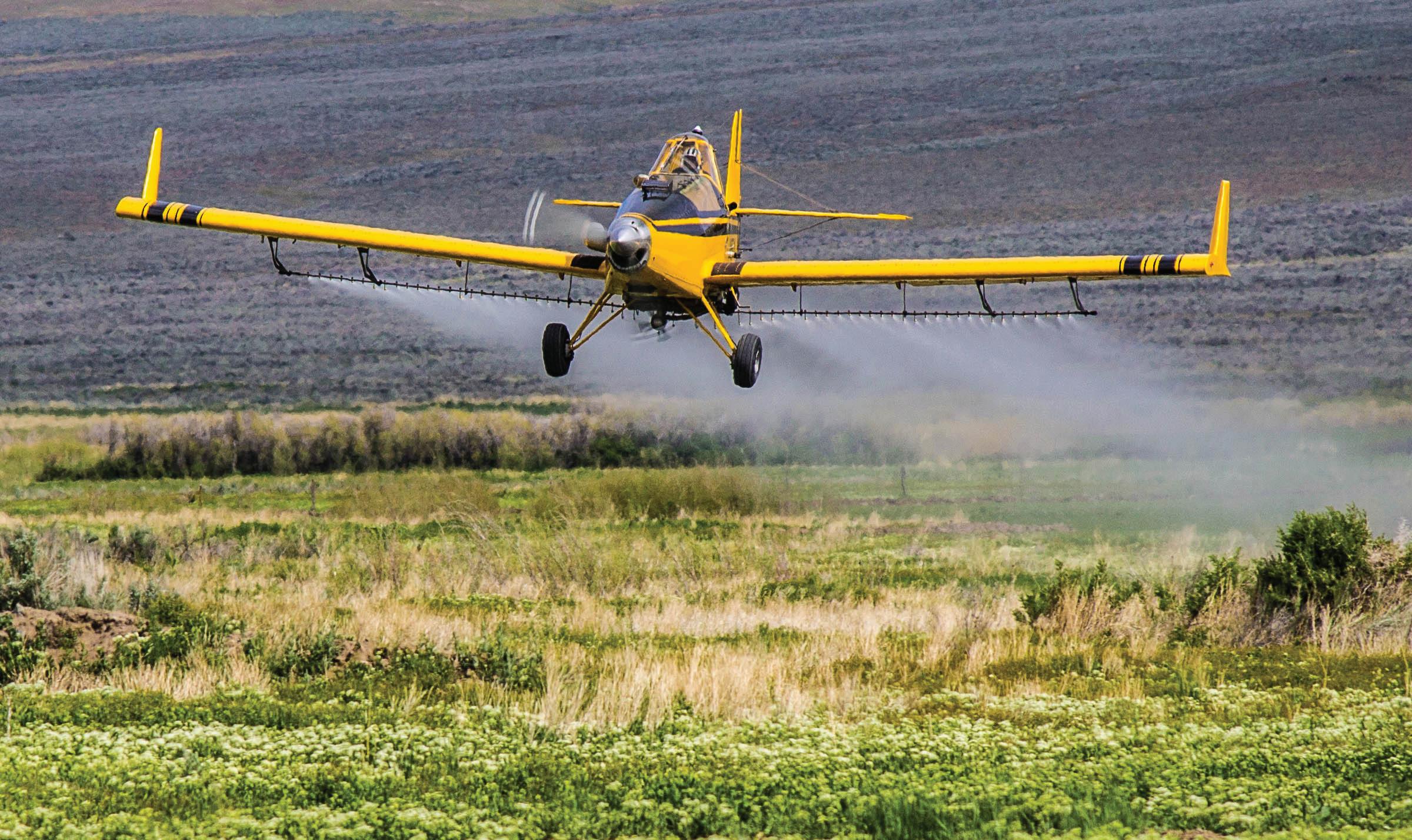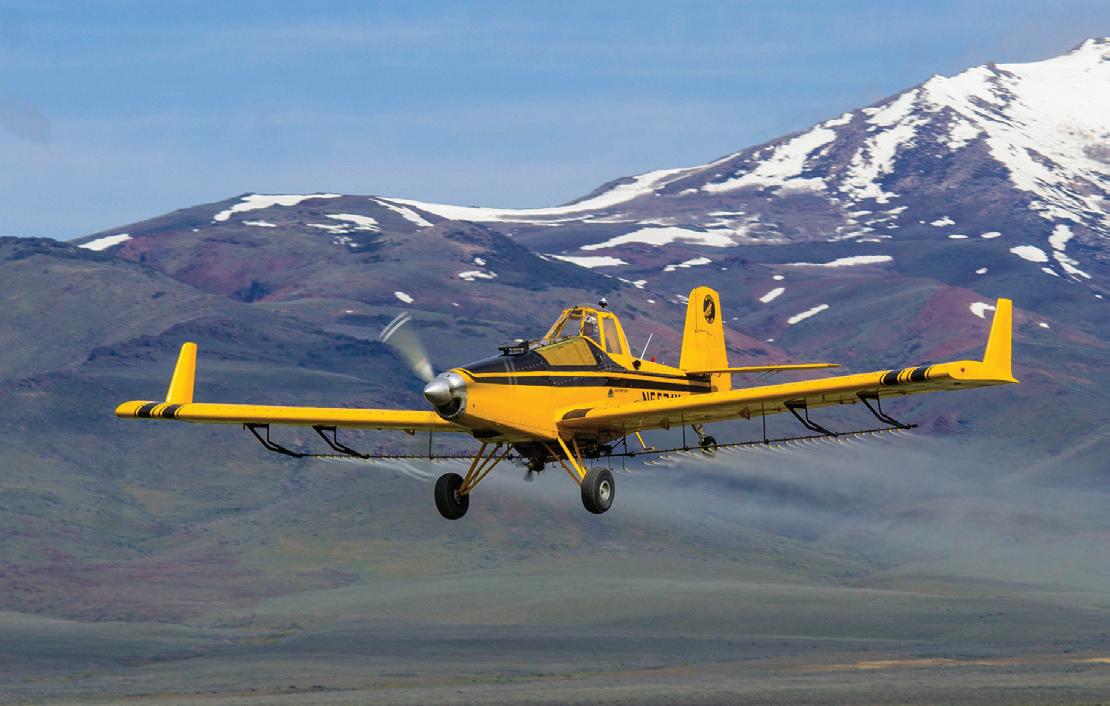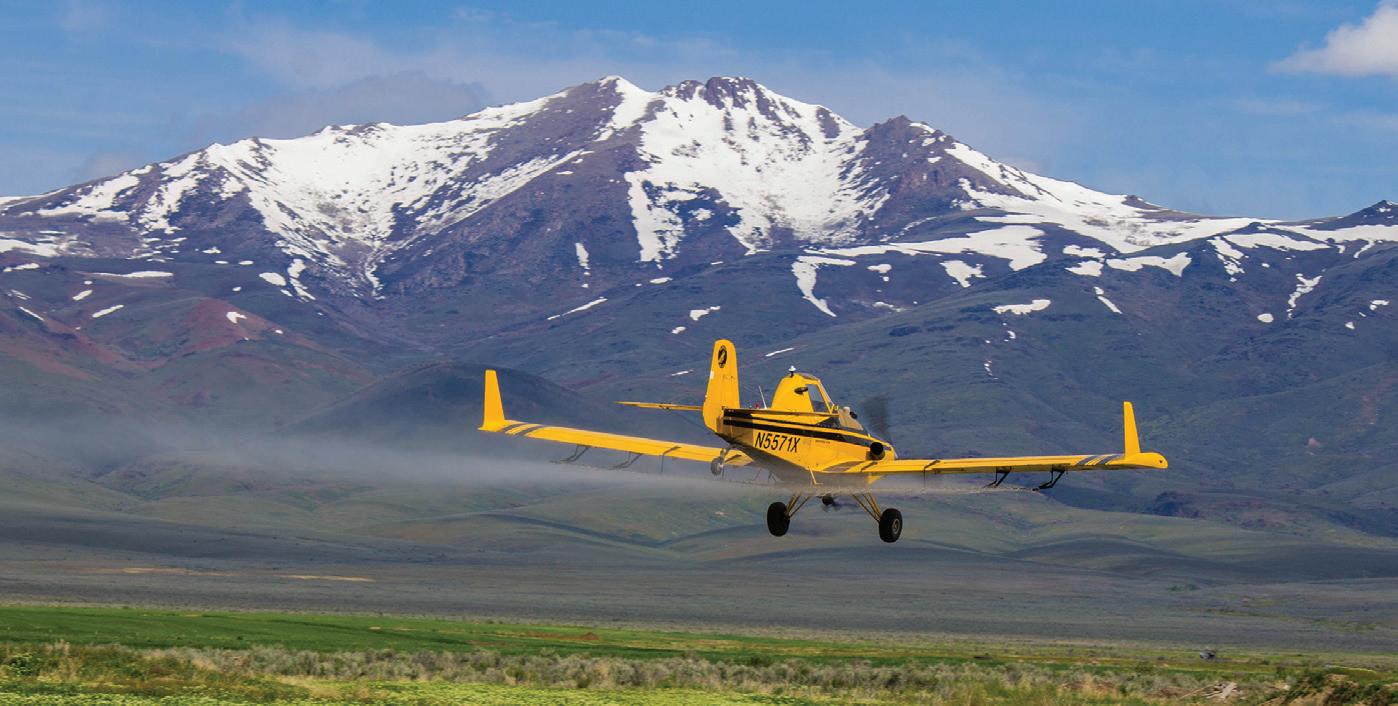







76 consignors brought in 2,360 head. The market was pretty strong yesterday across the board. We had some really nice cattle in all weight classes so it was a pretty good test.
It’s a very interesting time to be an American. The major shake-up in Washington has been captivating. So many of us have been affected by the overburdensome government regulations and bureaucrats. Job creation in America should be focused on building something, producing something, making our country stronger and more independent, making someone’s life better and better doesn’t mean easier. For many Americans life has become too easy, we need to get back to work as a Nation. Kids need to learn how to work again. For too many years now, job creation has been inventing new government positions and filling them with college educated idiots. As a result, those of us in the private sector have been over taxed, over regulated, and just flat out harrassed by these bureaucrats. So much so, that many of us have thrown in the towel. This country as a nation is headed to a hungry place, it’s unfortunate that many Americans are going to need to get hungry before they wake up.
I am Pro-America, I am not going to apologize for thinking we should put America First over our neighbors. Ranchers don’t get up in the morning and go feed the neighbors cows and break their neighbors ice, they take care of their own first. We need to start doing the same as a country. I’m so sick of the pandering, guilt ridden, ass kissing of Mexico and Canada.
American ranchers and farmers are going out of business at an alarming rate and nobody wants to address the elephant in the room which is the cheap imported, lower quality beef. LMA wants to focus on “Producer Profitability” but won’t let you whisper the word MCOOL or talk about imports. Meanwhile, they are having auctioneering competitions at the Mexican border, selling Mexican cattle, for a guy who is on podcasts lecturing America on why we need to support Mexico over America. Am I crazy for thinking there’s something really wrong with that thought process?
NCBA, We don’t really know what they stand for other than they are against MCOOL, they think global warming and being “carbon neutral” are top priorities. But first you have to believe that there even IS global warming, before you can buy that lie. We can’t count on NCBA to do anything that will help American ranchers. They are going to continue taking your checkoff dollars and using them against you, by lobbying against MCOOL and anything else that might take a dollar out of the packer’s pocket and put it back in an American rancher’s pocket. Something needs to be done about the direction we are heading, you don’t have to be too bright to see where we are going. Just look where the sheep industry is, that was caused by cheap imports and overburdensome government regulations. Let’s not keep our heads in the sand while it happens to the cattle industry.
In closing, I notice how much we at United States Cattlemens Association and even more so at RCALF scream and yell about imports and MCOOL but we haven’t been able to get the consumers riled up. That’s who should really be pissed off about the “24 hour rule”. Every chance I get, I ask folks I talk to if they know imported beef only has to be on US soil for 24 hours before it can be labeled “Product of the US”. NOBODY knows that! How as an industry do we continue to think it’s OK to lie to our consumers for the financial gain of China and Brazil? I can’t even begin to comprehend that thought process.
Anyway enough about that, hopefully DOGE gets to the bottom of corruption in USDA, Forest Service, USF&W and BLM. Hopefully We can get something done BEFORE fire season gets here, hopefully Trump recognizes what’s happening with all of the Wolf bullshit.

The only thing that makes my blood boil more than “buy the lie” on imported beef, is watching wolves drag down and kill both wildlife and livestock. The wolf deal is all part of “The Big Plan” as I call it. To wipe out the ranchers, wipe out all the big game, control the food and control the people. The sooner we recognize this, the sooner we start to understand the big picture.
Next Feeder Sale March 21st, should be a good run of all classes. Expecting 5000 plus. Please don’t be afraid to share your thoughts on the state of the American cattle industry either in the comments on this post, text me or call at 775 217 9273. Thanks everyone, don’t give up the fight for what’s right and don’t let them make you feel guilty for being America First!








































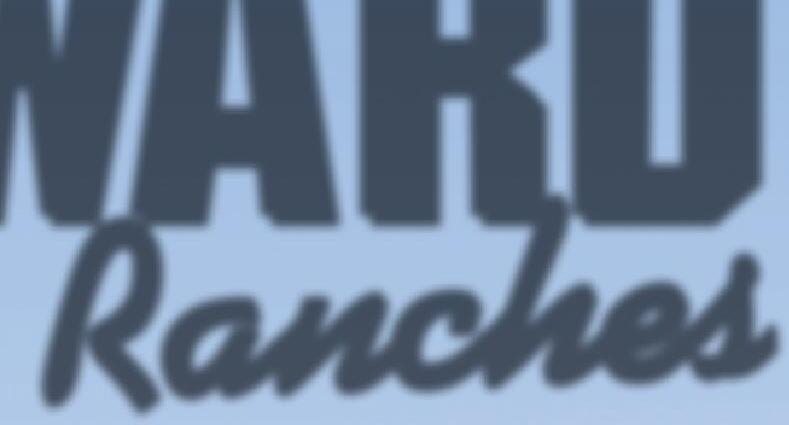


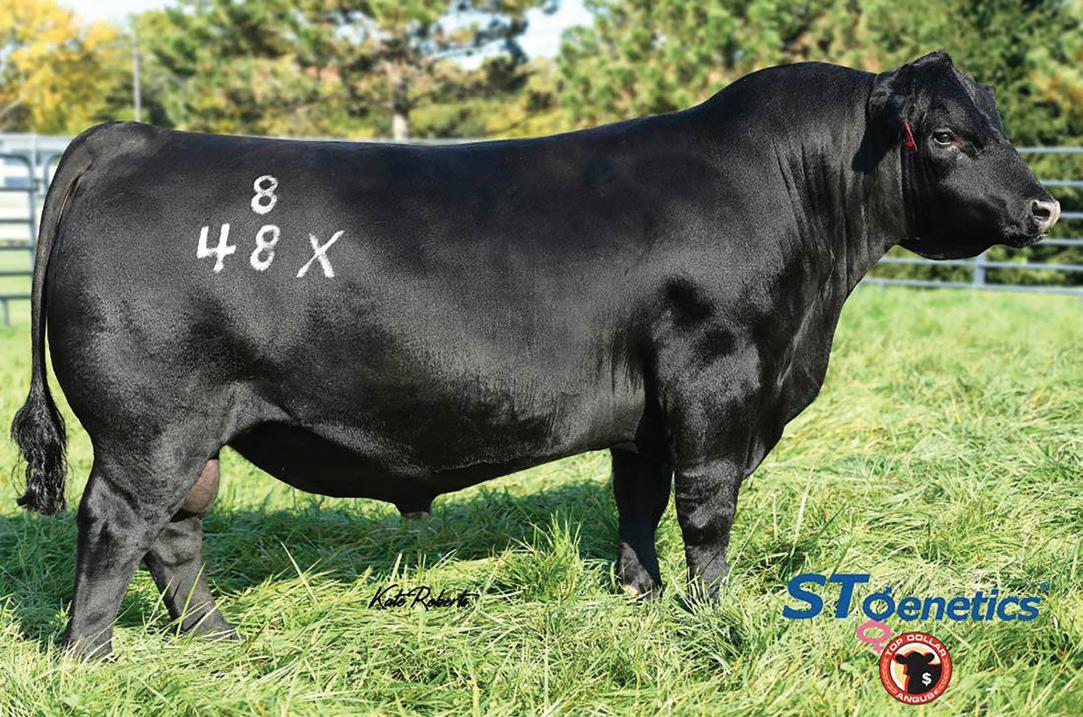






















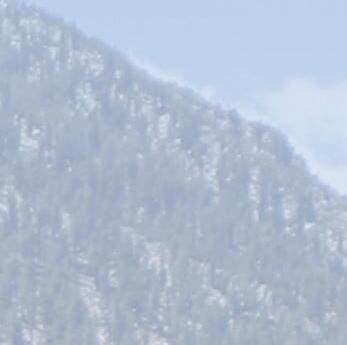



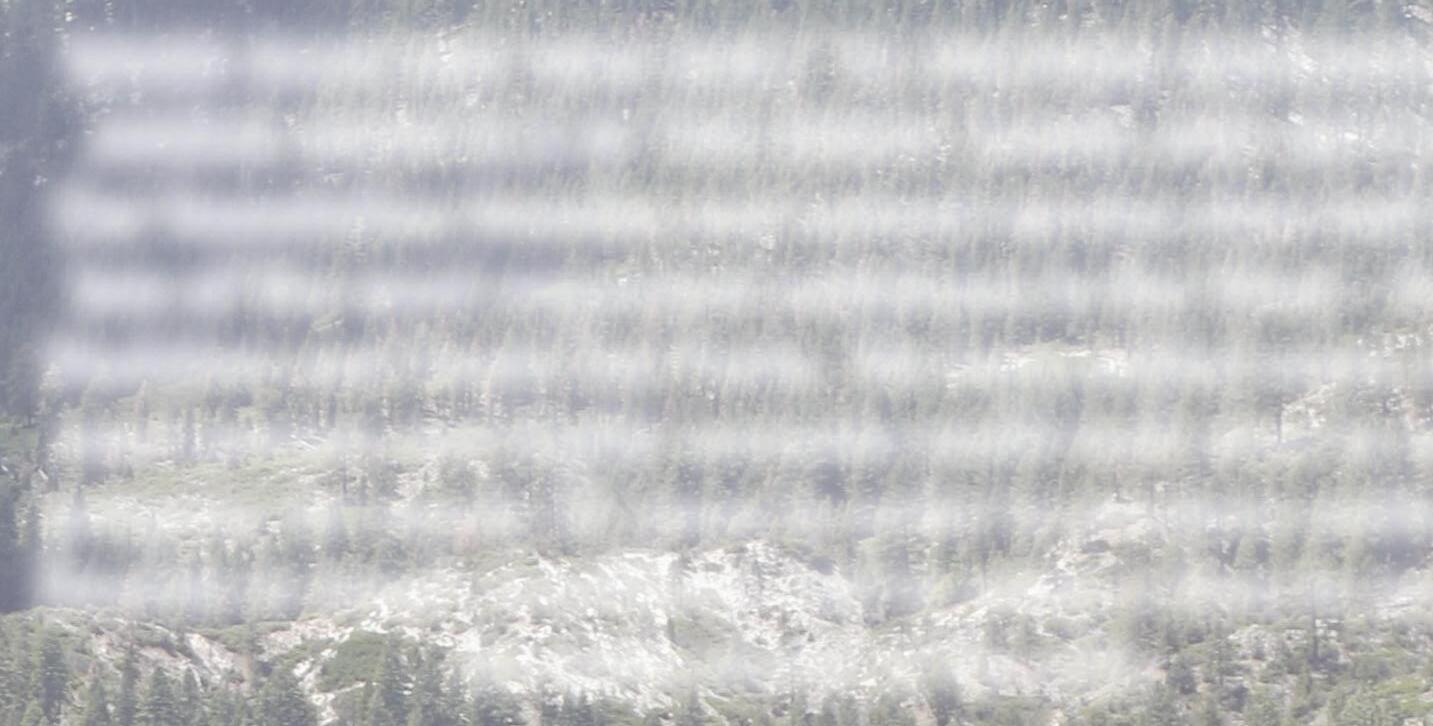
WARD RANCHES WAS BUILT TO PROVIDE SUSTAINABLE ANGUS GENETICS IN THE GREAT BASIN AND BEYOND. Our foundation females and natural service sires hail from two of the most respected cattelmen in the West - David Medeiros and David Dal Porto. We have added some of the most proven and highly accurate multi-trait sires to our AI program for nearly 20 years in order to produce cattle that flourish in tough conditions. Call to setup a time to preview the bulls ahead of the sale.

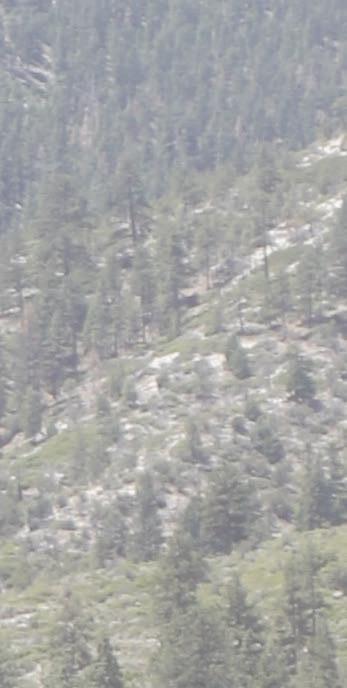

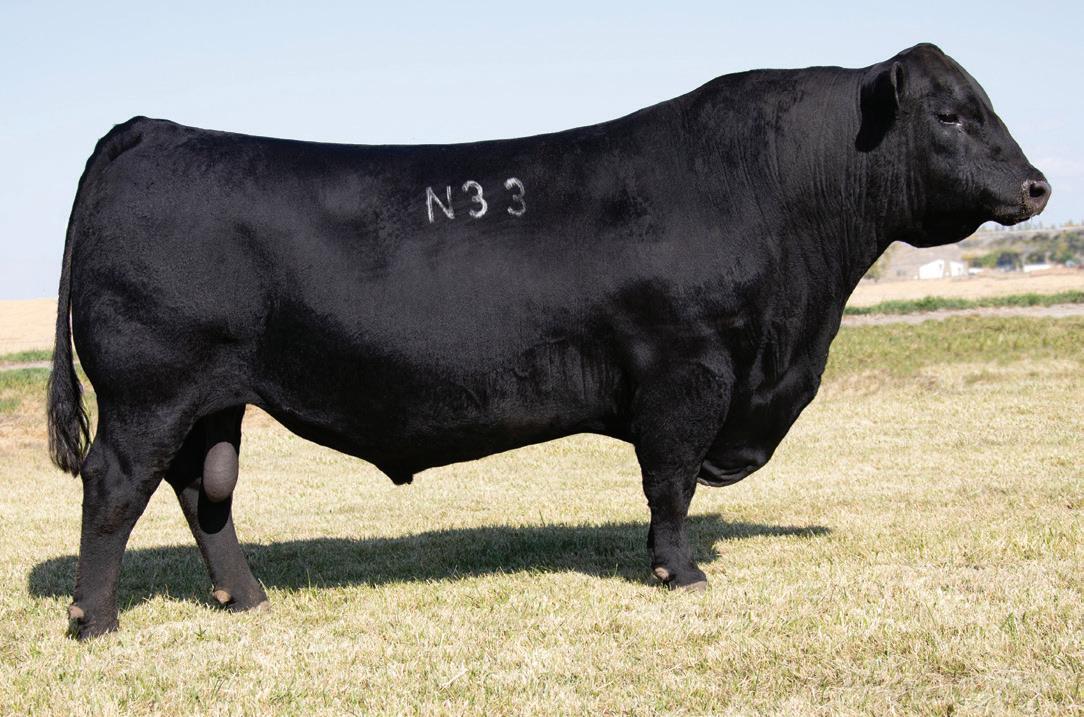





























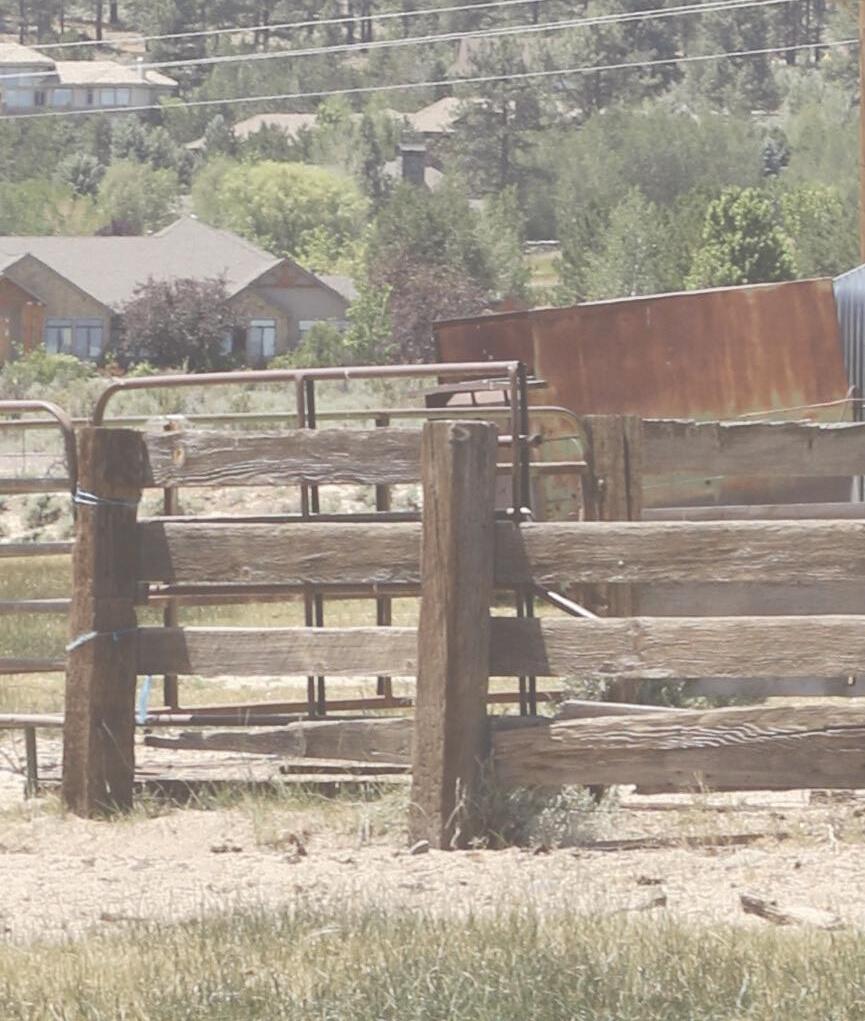
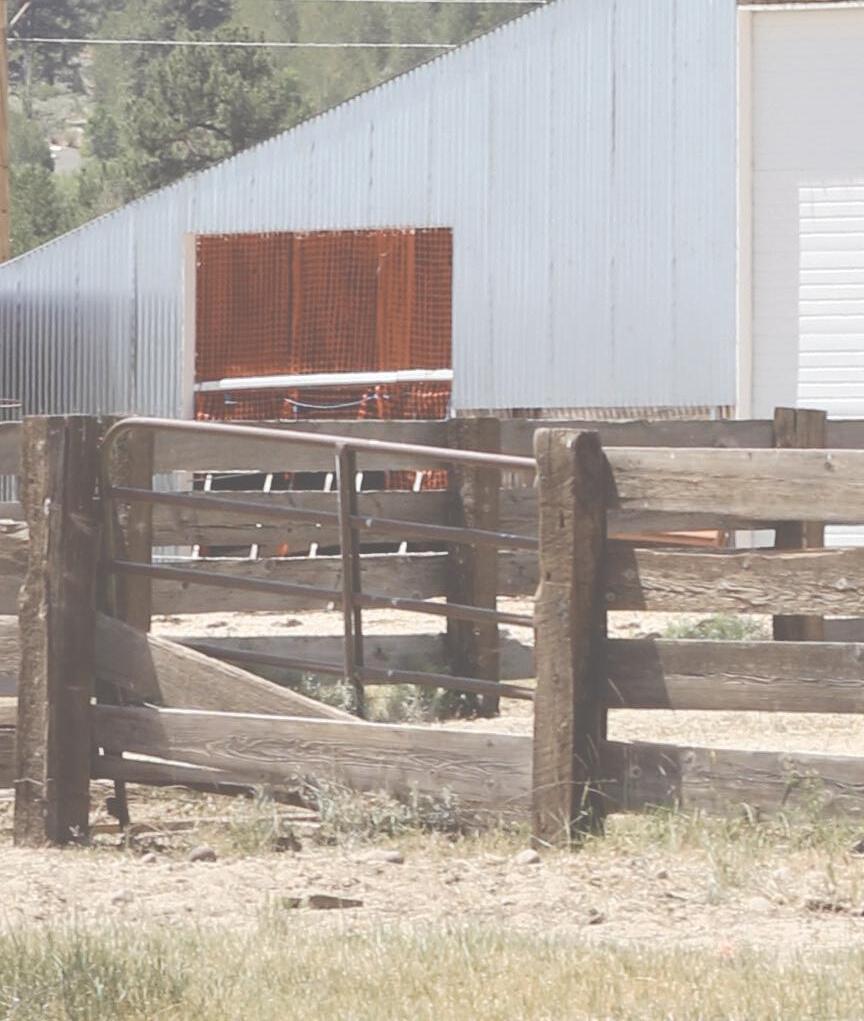

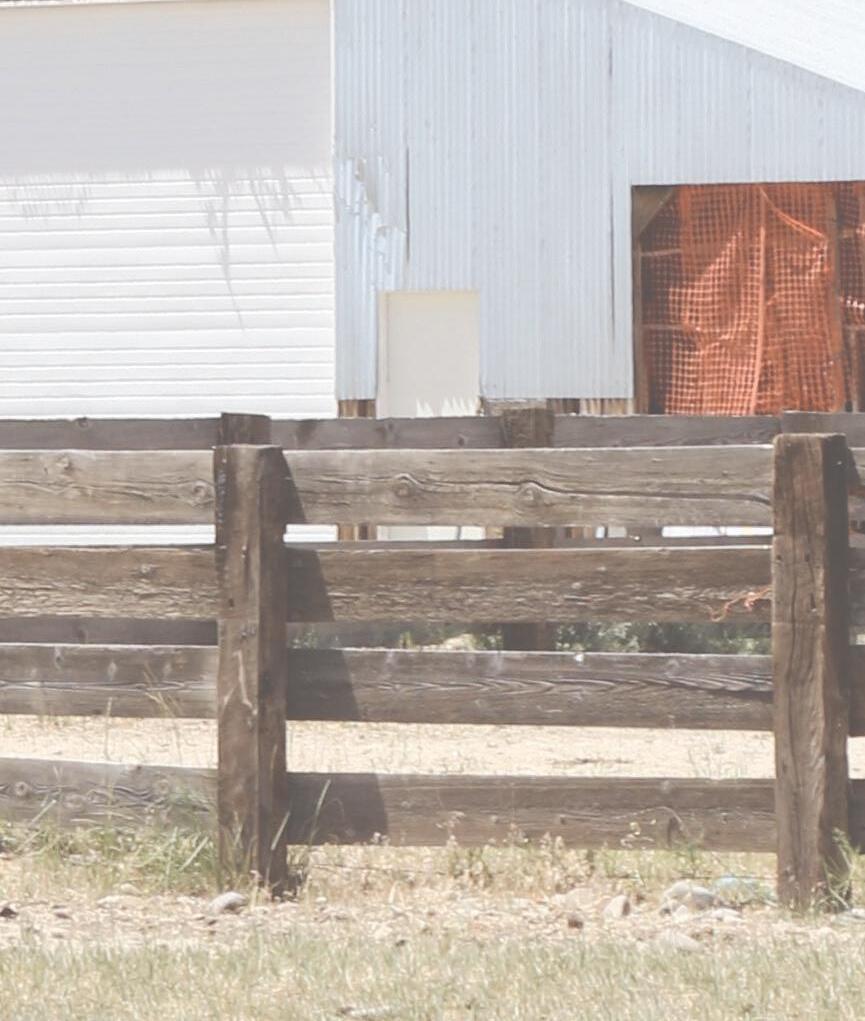




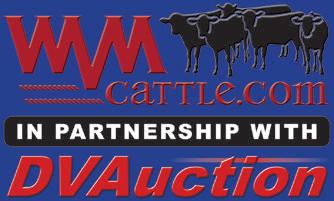


Subscribe today for Just $16 per year! (775) 623-5011
Read back issues digitally: issuu.com/winnemucca
publishing7
The Nevada Rancher (ISSN 0047-9489) (USPS #003-257)
Published monthly at Winnemucca Publishing, 1022 S. Grass Valley Road, Winnemucca, NV 89445
Call us toll free at (866) 644-5011
Periodical Postage Paid at Winnemucca, 89445
President: Peter Bernhard
Publisher & Editor:
Ashley Buckingham
Staff Writer: Jennifer Whiteley
Contributors
Martin Paris, Norma Elliott, Randi Johnson
Sales Representative:
Ashley Buckingham
Office Manager: Tracy Wadley
Graphic Design:
Ashley Buckingham
Joe Plummer
Emily Swindle
The Nevada Rancher does not assume responsibility for statements by advertisers nor products advertised within, and The Nevada Rancher does not assume responsibility for opinions expressed in articles submitted for publication. The publisher reserves the right to accept or reject advertising or editorial material submitted for publication. Contents in The Nevada Rancher may not be reproduced, in whole or in part, including, but not limited to original contents and original composition of all ads (layout and artwork) without prior written permission. Subscription rate: $16.00 per year. All content copyrighted, March 2025.
POSTMASTER: Send address changes to: The Nevada Rancher, Winnemucca Publishing, 1022 S. Grass Valley Road, Winnemucca, NV 89445
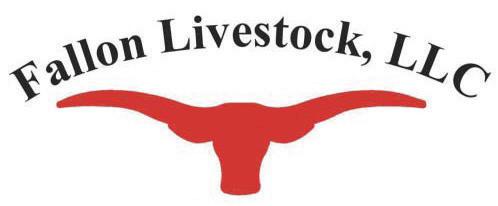

I’m not sure why I’m surprised that one day it was 65 degrees and sunny and the next it was 30 and snowing. Good Ol Nevada. The past month of February was busy for the NV Rancher! We attended bull sales and had the opportunity to visit with familiar faces we don’t see often!
I hope this month continues to bring moisture, welcomes healthy babies, and plenty of love and laughter. This edition may look a little different than usual, as we experience some transition within the company. Thank you for the continued support, positivity and readership! Please support these advertisers within the publication when you do business.

Thank you and as always, I hope you enjoy!
this
Ranching Scrapbook - pg. 12 & 13
2025 Cowboy Arts and Gear Museum Bit, Spur, and Rawhide

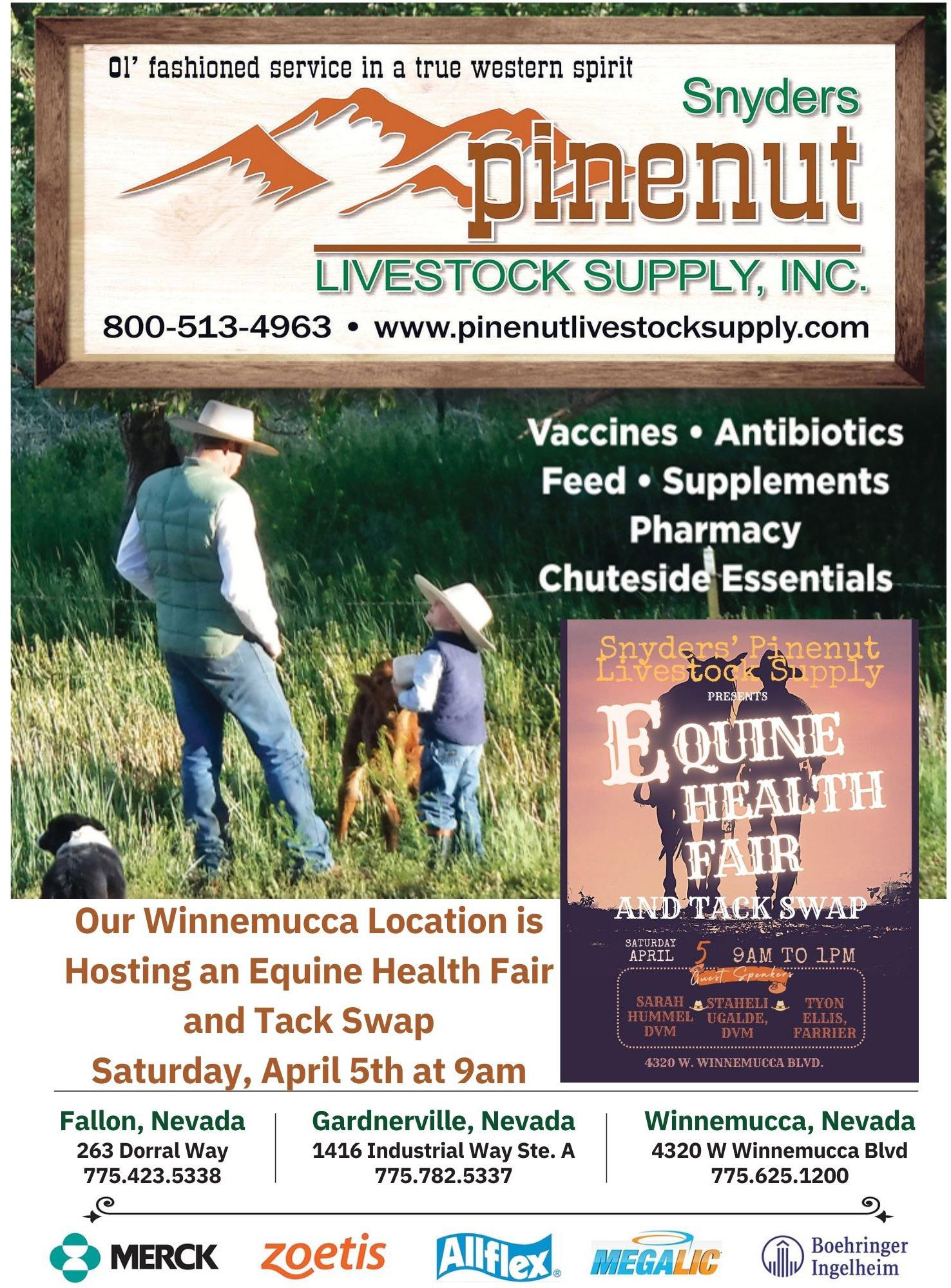

Virgil Larios
October 25, 1940 - January 31, 2025
Virgil Larios, 84, of Winnemucca, Nevada passed away with loved ones by his side, on January 31, 2025 after an untreatable pancreatic cancer diagosis10.5 months prior to his passing. He was born in Twin Falls, Idaho on October 25, 1940.
Virgil and his sister Sandy, and their parents Fred and Dorothy Larios lived/worked on Larios family ranches in Northern Elko County, the Jones Ranch, Anderson Ranch and Diamond A Ranch.
They also lived several years in Jarbidge, Nevada. Virgil and Sandy attended school in Jarbidge and when they were living on the ranches, they attended school in Rowland, traveling by horseback to and from school, winters and all.
On occasion they would encounter mountain lions, but luckily their horses were very trustworthy and solid guardians and nothing bad ever happened on those long rides to and from Rowland.
His Father Fred and his Uncles, the ranch life, the cowboy way and Jarbidge shaped Virgil into the person he was throughout his life. Something he would later pass on to his Grandson, Cole Hatcher, who was Virgil’s best friend and whole world for almost 24 years.
Virgil and his family relocated from Jarbidge to Carlin, Nevada so he and his sister could attend high school there. The Jarbidge School only taught through 8th grade. Virgil graduated in 1959.
Virgil met Deanna (Dee) Sample of Castleford, Idaho at Murphy’s Hot Hole, near Jarbidge. The two fell in love and were married on August 30, 1959. Jarbidge remained a frequent vacation place for the couple and later with their two daughters, Tanya and Lana. Virgil felt so grateful to have had good enough health after his diagnosis, that in the summer of 2024, he was able to go up to his beloved Jarbidge four times for almost a total of four weeks. They have had a family cabin there for many years and it is a
favorite family destination.
Virgil began his working career after high school with Boyles Brothers Exploration Drilling and he and his new bride, Dee relocated to a drilling project in Redding, California. Work with Boyles Brothers for several years came with many relocations to new projects. Virgil and Dee moved about 36 times during his employment with them, including to Puerto Rico. They made many lifelong friends during those years.
After their first daughter Tanya was born in 1966, they decided to move back to Nevada to be closer to family. Virgil got into Mining in the Carlin area around 1967, the same year their second daughter was born. He worked at Newmont/Cortez for several years.
After accepting and relocating to a couple other employment opportunities in mining in Wyoming and Montana, the family came back to Carlin, which had always been their home base. Virgil and Dee then both accepted jobs in Winnemucca with Pinson Mine in 1980 and that move made their 40th and final move. They settled in Winnemucca and their daughters both graduated from Lowry High School. Virgil worked at the Pinson, Prebble, Dee Gold mines and in the 90’s he and Dee both worked at Marigold. In 2001, after open heart surgery, Virgil found himself retired. Although he stayed busy with his Grandson Cole, who lived in Winnemucca, and was active in sports and high school rodeo, he ultimately ended up working at Min-Ad for several years until just a month or so before his passing. Work was like a hobby for him, especially once his weekend cowboying hobby was no longer physically possible. He was a Dad, Grandpa, Friend, one tough man, a hard worker his whole life, more soft-hearted than he wanted people to know, loyal, trustworthy, honest and some might say he could be feisty and ornery, but if he wasn’t giving you a hard time, that probably meant he didn’t like you.
Virgil was preceded in death by his parents, Fred and Dorothy Larios, his sister, Sandy DelSarto, his wife, Dee Larios and his grandson Cole Hatcher.
He is survived by his two daughters and son in laws, Tanya (Darrel) Greene, Lana (Kevin) Kapphahn, grandson Cody Kapphahn, great grandsons Cashton Cole Hatcher and Huxton Slotten and Salone (Zayne) Slotten. Also longtime girlfriend Sue Coutts, her sons Darrel Coutts, Steve (Miranda) Coutts, Granddaughter Jordyn (Frankie) Dean, great granddaughter Brinley, great grandson Cohen, granddaughter Megan (Bryce) Yacobi, Xavier Yacobi and numerous other family.
Per Virgil’s request, there will be no services.


Pyper Jean Dalton
February 28, 2018-January 18, 2025
Pyper Jean Dalton was born on February 28, 2018, accompanied by her twin brother, Jackson, to Cameron Edgar and Emily Ann (Cook) Dalton in Twin Falls, Idaho. Pyper Jean was a fun, kind-hearted, sassy young lady who loved her family and animals. She loved

Zatica
October 7th, 1934- February 17th 2025
Jim Zatica, 90, of Jordan Valley, OR passed away in Homedale, Idaho on February 17, 2025.
Jim was born on October 7, 1934 to Basque immigrant parents, Joe and Ignacia (Bilbao) Zatica. There is some debate on his actual birth year as Dad always told people that he was born in 1933. Either his birth or baptismal certificate were incorrect. He was the last child born into a family of six children and was spoiled greatly by his older sisters. Upon entering school, he could only speak Basque but managed to Americanize and graduate from Jordan Valley High School in 1952. He joined the Army and was present at the nuclear bomb testing in the Nevada desert. In March of 1959, Jim married Peggy Key. Mom and Dad formed a partnership of brains and brawn starting their own business from nothing in Jordan Valley. Thus began many years of gallons of gas being pumped, tires being repaired and countless employees being taught how to work and the necessary skills to thrive. Dad was immensely proud of his Basque heritage and exemplified the tremendous work ethic that is Basque. It was
helping her dad and mom care for the livestock all around the ranch. Pyper stood her ground for what she believed in. She lived up to the spice of her red hair. This past summer, she had started following in her mom’s footsteps and becoming addicted to barrel racing. She loved to help gather cows and decided her dad’s big, new horse now belonged to her. She loved going with Monga Dani to bake, go on outdoor adventures out their back door, and just hang out. Going to the cousins’ house to get her nails painted pink was always a must. Giving out hugs to those she loved at school when they were least expecting it was who she was. Pyper Jean will be greatly missed by her parents; Cameron and Emily, twin brother; Jackson, paternal grandparents; Brad and Dani Dalton, maternal grandparents; Dave and Evelyn Cook, great grandparents; Vernon and Joanne Dalton, aunts, uncles and cousins; Ryan and Dana Brodsho (Callie, Josie, Chance), Jay and Missy Dalton, and Ethan Cook and Jenna Brough (Bobby, Billy), other extended family, community, and all those who knew her sweet little personality. Our family and community gained a very special little angel to always watch over us.
commonplace for Dad to work literally night and day to support his family and fledgling business. Life was not all toil as Dad had an excellent sense of humor. Almost everyone he encountered was given a nickname and his life was full of laughter and teasing peppered with cussing. He was a loyal friend to many and had an immensely kind, soft heart. Dad was a huge, loving presence in our lives. He taught us how to hunt and countless memories were made mostly involving sore feet, buck fever and poor shooting. He taught many of us how to play basketball spending numerous hours scrimmaging with teenagers much younger than him. He held his own with his lightning quickness. He served his community as a member of the city council, school board, and cemetery board. Dad was a charter member of the Lions Club. He was a lifelong parishioner of St. Bernard Catholic Church. After years of hard work, Dad's body began to fail, and he entered Owyhee Health and Rehab in Homedale. We would like to thank the staff for not only their care for Dad but the love that they showed him. He made many close friends; many thanks to them as they looked out for Dad in his final days. Dad was extremely grateful to the priests that visited and brought the sacraments to him in the nursing home.
Jim was preceded in death by his wife, Peggy; son, Kevin; his parents; sisters, Sola Staley and Julie Yzaguirre and brothers, Jess and Paul Zatica. He is survived by his sister, Mer Cortabitarte; daughter, Lee Ann Conro (Mike) and grandchildren, Kelly Chamberlain (Tyler); Patrick Conro (Logan); Ashley and Melissa Zatica, and two great-grandchildren, Harmony Hernandez and Graysen Conro and many beloved nieces and nephews. Memorials may be made to St. Bernard Catholic Church, PO Box 186, Jordan Valley, OR 97910 or Txoko Ona, PO Box 1163, Homedale, ID 83628 or the charity of your choice. Ongi bizitako bizitza, goian bego! A life well lived, rest in peace.
Happy March everyone! March is one of my favorite times of year with lots of good college basketball and of course, the beginning of calving season for most. It’s been a pretty warm winter thus far, but my fingers are still crossed for decent calving weather.
NCA leadership recently attended the National Cattlemen’s Beef Association Convention in San Antonio, Texas. As always, there were plenty of issues discussed and a lot of good takeaways. The new Administration has thus far taken the phrase “hit the ground running” to a whole different level. As the Executive Orders and policy changes continue to roll out at a breakneck speed, there’s a lot left to be determined as far as what it all means for livestock producers. By the time you read this, there should be cabinet level and other key leadership positions filled at the various federal agencies. These folks will be tasked with carrying out and implementing the Administration’s vision and as they get settled in, we should start to see things take shape. Over the coming months there is likely to be the opportunity to address several issues and NCA is eager to engage on building a strong future for agricultural policy.
The things we do know at this point in time- the Bureau of Land
Management’s Public Lands Rule has been put on hold indefinitely. As a refresher, the Public Land Rule was made effective in the summer of last year and allowed third party entities to lease public land for up to 10 years for the purpose of restoration activities. The issue at heart is whether or not the BLM and the Rule considered livestock grazing to be compatible with these restoration efforts. Since the rule became effective, there has not been a restoration lease established on federal lands. NCA worked hard to secure representation on the BLM Public Lands Rule Advisory Committee in the event the Rule were to continue forward, however, the committee’s work has been indefinitely postponed along with the implementation of the Rule at this point in time. NCA stands at the ready to ensure livestock grazing is protected should the Rule be considered at a later point in time. Also in the midst of the transition, NCA filed a protest against the latest edition of Sage Grouse Land Use Plan Amendments. NCA’s protest cited a lack of coordination, rushed timeline, lack of consistency with the state’s plan, inconsistencies with mapping and other data, amongst several other concerns. At the end of the day, the Record of Decision for the proposal was not signed for the Nevada/California
plan amendments. This means that for now, Nevada is currently operating under the guidance of the 2015 Sage Grouse Plans. Newly appointed Secretary of the Interior, Doug Burgum, has released several Secretarial Orders in his first few weeks on the job. One of which dubbed “Unleashing American Energy”, provides some much-needed regulatory relief. While the Order is primarily geared toward expanding domestic energy production, livestock grazers may find some solace in that the Order calls for revising all relevant drafts and finalized resource management plans involving sage grouse. This may provide the opportunity to provide some much-needed edits to the plan that will actually recognize the positive impact livestock grazing can have in sage grouse habitat.
On another front, the 83rd Session of the Nevada Legislature began on in the first part of February. NCA has been hard at work reviewing each piece of legislation and its potential impact on agriculture throughout the state. Be sure to stay tuned for updates on the happenings at our State Legislature. Until next time.
Martin Paris, NCA Executive Director
It’s come to my attention lately that a lot of folks really don’t know just what NCA does. I have had quite a few neighbors, friends, or even family ask me to enlighten them on the activities of our organization and when I start enlightening them, they are always surprised. Not only slightly surprised, very surprised! The level, frequency, and intensity that we work catch most people off guard. The common theme of “I didn’t know you had that much impact” is most frequently the reply.
As this conversation is continuing to happen I feel compelled to touch on it in this month’s article. We've been accused of being the “good ol boys club” sitting around drinking martinis. In all my time with NCA I still haven't been invited to a martini lunch! Ranchers typically have an introvert personality compiled with a recluse mentality. Self-promoting just isn’t in their nature. A sale yard owner that likes to throw rocks from 100 miles away recently went on a rant about a past president of NCA tearing him down saying he just works for a big pharma company insinuating that he doesn’t care
about the livestock business in Nevada. If you don’t think Jon Griggs has done more good for the ranching industry in Nevada you need your head examined! The problem is he quietly does it in the shadows.
A hallway conversation with an Agency person, a quiet lunch with a Senator, or a vote at the NCBA convention that may or may not have went the way we would have liked it to go are just a part of what NCA does for its membership but no one ever sees. Our work in the shadows will probably never change but that doesn’t mean we aren’t doing it. Don't believe the rock throwers. If you have questions about what we do, feel free to ask us or better yet come to the meetings. Come to the Convention and get involved. Well enough rant from me this morning. I’m off to try to get something done in the shadows!
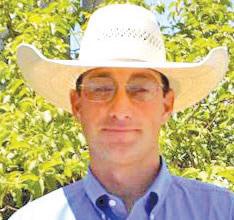
CheersHanes Holman, NCA President
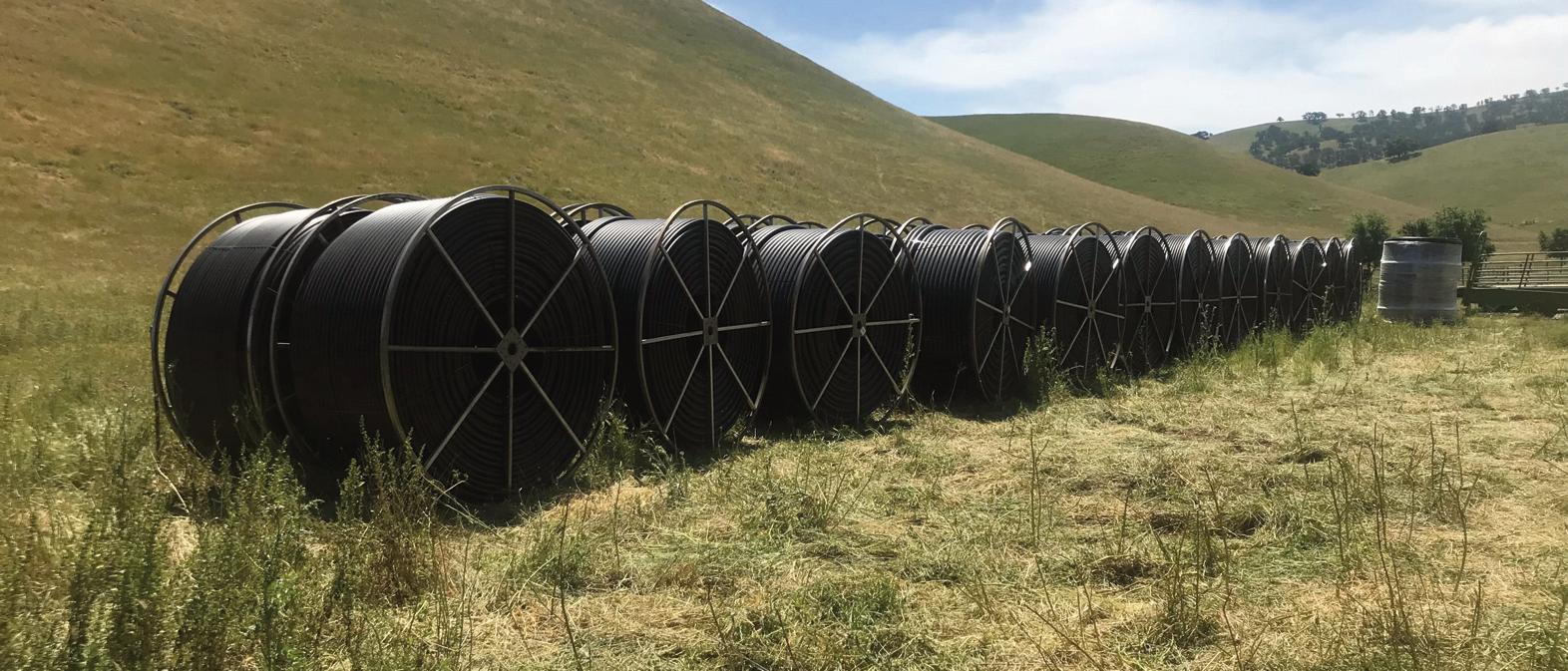
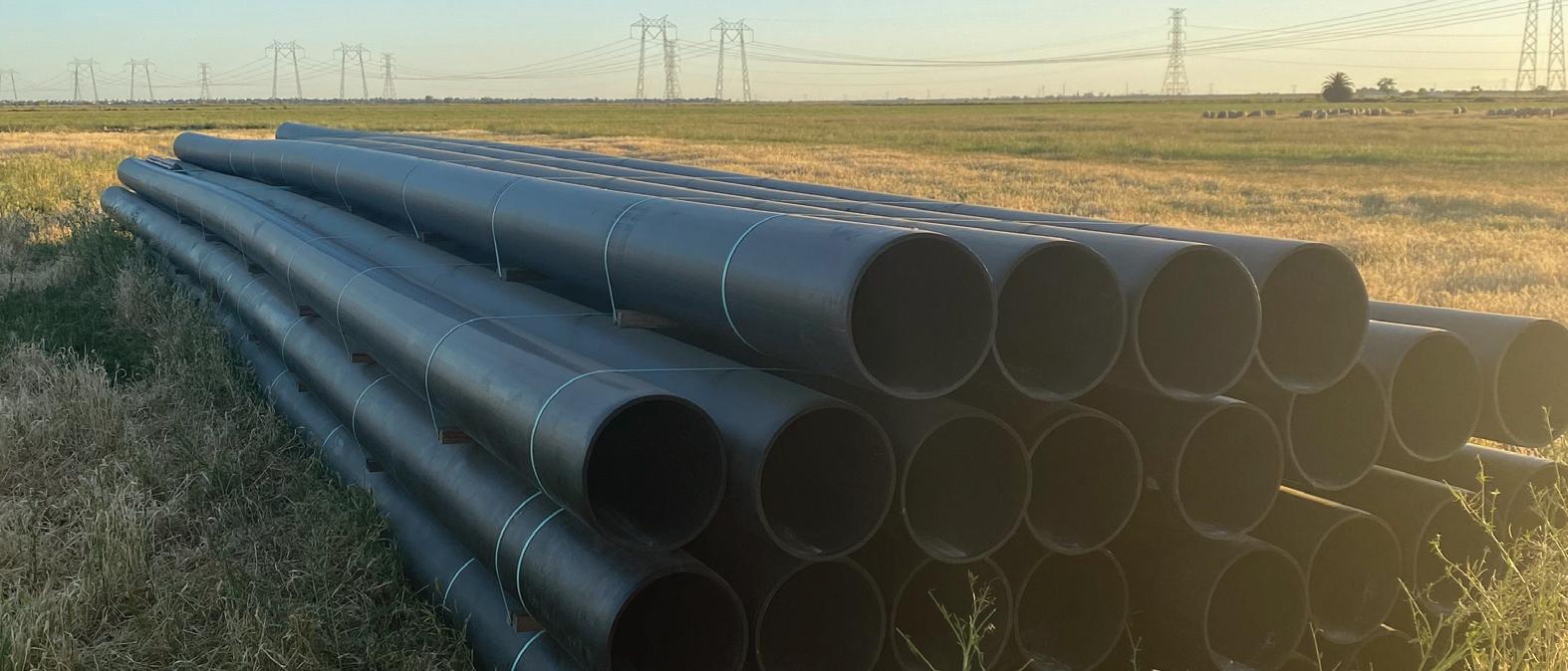
By Heather Smith Thomas
Most purebred breeders and many commercial producers raise their own replacement heifers. They use various ways to decide which ones to keep; selecting replacements usually involves evaluating conformation and temperament along with use of tools provided by modern technology.
A growing number of producers, both registered and commercial, are discovering the benefits of using genomics as one more selection tool when trying to improve the cow herd. Many producers have already been using this tool when selecting bulls and some are now using it to help select heifers. Scott Paxton (SV Cattle Company, in Sterling, Colorado) has used genomic testing, specifically the Igenity Beef program from Neogen, on the Angus Bulls he sells in their annual sale.
“We are selecting a few more things today with genetic testing to improve our cattle. One thing we can do today is determine which animals might be susceptible to bovine congestive heart failure (BCHF)—which has become a big problem in feedlots. The last 3 years I’ve tested our bulls and have had those scores available on our sale bulls,” says Paxton. Even when selecting heifers, all these things play a role because selecting the right bulls makes a big difference on what their daughters will be.
“Two traits the American Angus Association hasn’t put much focus on is bovine congestive heart failure (BCHF) and stayability. I think the Association is starting to look into thesetraits because they have significant economic impact on the commercial cattle industry today. The problem is, it’s hard to find some of those genetics when we haven’t been selecting
for them over the years. We are starting from behind,” he says.
“This is where the Igenity beef test has been helpful for me, because I can select bulls that are high in stayability, or not use bulls that are low in this trait or in heart health,” says Paxton.
in each of their operations. It starts with genetic awareness of their own herd, their ability to select the best heifers to meet their program criteria and then select bulls which directly address deficiencies (in the cowherd/heifers) to move forward faster than just sorting replacement heifers based on visual phenotype

For many years he has helped some of his commercial customers use genomic trait selection to sort through their own herds to select their top replacement females. This testing uses 16 different traits on a maternal or production index which address specific needs
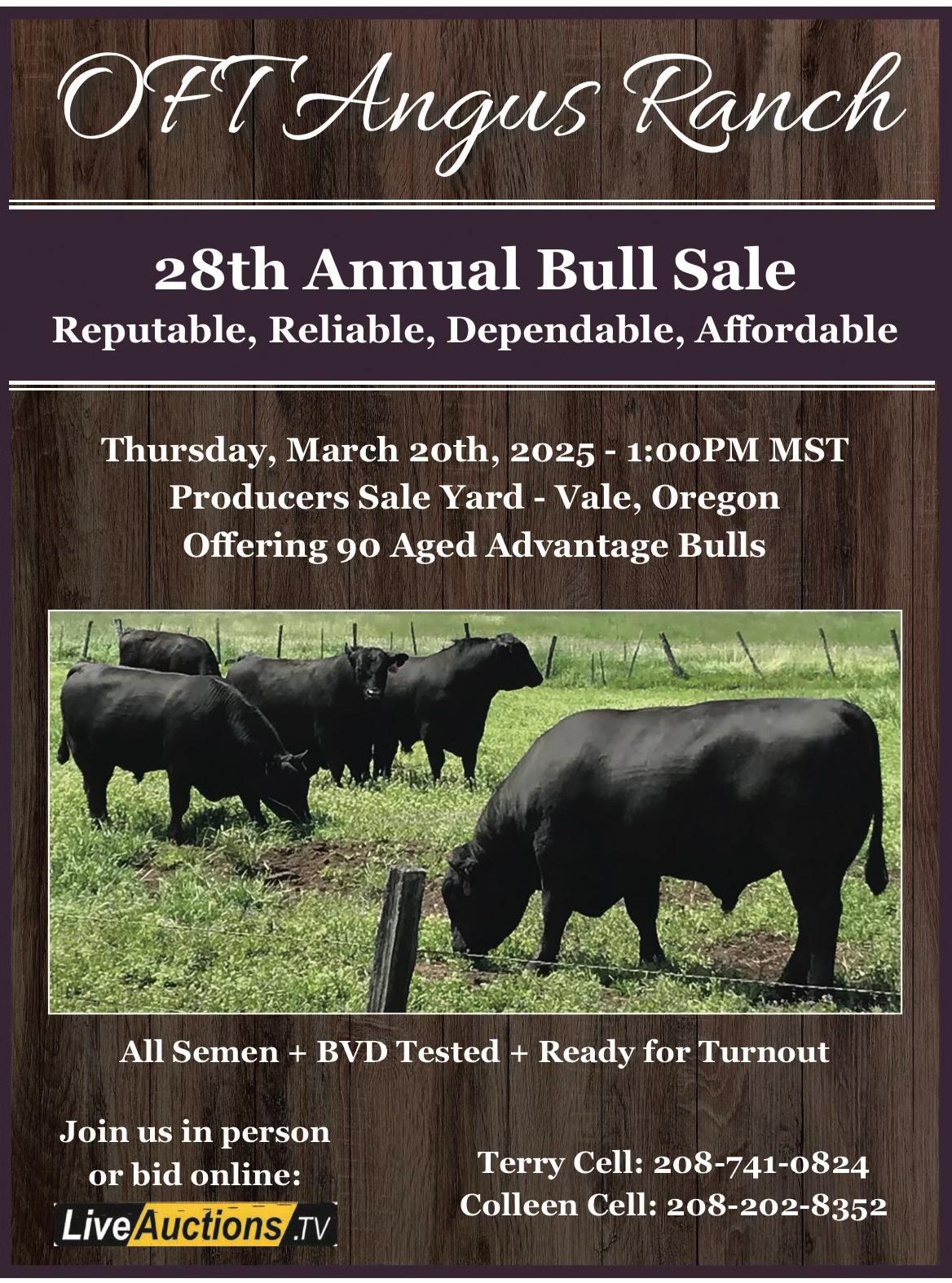
selection.
“This commercial DNA test was based on the 8 largest (in head number) beef breeds plus heavy influence from most of the small breeds. This program can have a huge impact on commercial cowherds across the US, which is more exciting to me than sorting through the Angus percentages on each trait and looking at EPDs to sort and breed our Angus replacements,” says Paxton.
Traditionally heifer replacements were sorted in an alley by size, structure, type and disposition. “This is still a vital part of the selection process but now we can add 30% more DNA information to our toolbox to select replacements –looking at genetic traits found under the hide that we can’t see. This information brings added benefits and value to a commercial program,” he says.
“The Igenity Beef replacement DNA profile is 80% accurate compared to a single breed profile such as Angus. This involves three parts. First is Genetic Awareness. What is under the cow’s hide? I’ve gone to customer herds and collected tissue samples (the size of a pencil eraser, out of the ear) from many heifers. The results take 30 days, at which time we can take the 16 traits of information and use an index from Neogen or build an index of their own (based on their own operation’s needs and goals) to sort from. This index can be maternally based or you can incorporate a second index that focuses on terminal aspects. All my customers have access to 3 indexes (Material, Performance and Terminal) to make their selection decisions.”
Another benefit is being able to correct deficiencies and weed out poorer traits. “SV Cattle Company ran our bulls on the same DNA Igenity Beef profile with the same 16 traits. This gives a customer the opportunity through bull selection (to use on their heifers) to use the same DNA language to correct the less-desired traits. Our bulls were sorted on the same Maternal, Performance and Terminal indexes, which ranks them from the best bull to breed to those heifers to the worst,” says
Paxton.
Third is Marketing Benefits, through Video Auctions. “Superior Video Auction is on board with this program and our customers can market their calves on Superior in two ways. First, by taking their samples (used for sorting replacements), and having the DNA sample of at least 35% of the calf crop represents all the calf crop (steers and cull heifers). Superior will market those calves in three categories based on the 35% tested: Elite = Top 75% of calf crop; Premier = Top 74% - 50% and Choice = Entry level genomics profile. Secondly, they could take individual samples of every calf and then sort the calf crop into load lots in the same Elite, Premier and Choice categories.”
There is a Maternal and Terminal index, and a Performance index in the middle which combines the two. “This is the one I recommend to sort heifers with, unless they want to build their own index. One of my customers is building his own because he runs cows quite a bit different than the norm. Dr. Paige Pratt is helping me with this. She is the Neogen technical support,” he says.
“Paige is phenomenal. We pulled her in to help with this rancher’s situation. He runs commercial Angus and they really have to rough it. We had a snowstorm in November and his area had over two feet. He was unable to see his cows (and the calves--wintering with their mothers) for about two weeks, but had them in a place where they could survive and he didn’t lose any. He grazes them year round so they have to be hardy and feed-efficient,” says Paxton.
“He rotates pastures and makes sure they have water, and before that storm he put them in an area where they had wind protection but still had to dig through snow to eat. His needs are a bit different from producers who feed their cows when things get harsh.”
This rancher used to run a lot of cows and spent a lot of money on feed and labor and now does it all by himself and doesn’t buy any feed.
“He cut the number of cows so his grass will maintain that number year round. He calves in June, July and August and the calves are big enough to handle storms, wintering with their mothers. He has taken enough of a different approach that the typical indexes we are trying to use don’t fit. With Neogen, however, we can build an index for his management style. He sells all his calves on Superior Video and they do great.”
Superior has a growing number of producers using Neogen programs. “You have to get the cattle certified and Superior advertises this in their catalog and on the screen during the sale. We have a customer who sorted his heifers with the Igenity Beef Maternal index and pulled out his replacements—and sold the rest of the heifers on
Superior for the Bell Ringer sale in January. He sold his steers on the July video for November delivery after weaning and they were at the top of the market. The heifers that sold in January had their indexes, and buyers could use those indexes and go either direction with them—as replacements or feeders,” says Paxton.
“There is a new feeding program here in Logan County, putting heifers on feed. They went on feed December 10 and will be fed until June and then harvested—to raise money for a certain benefit. One of our newest customers has 200 heifers and we sorted
through them and she put three on this heifer feeding trial. Their maternal scores weren’t very good, their terminal scores were phenomenal and their performance index was good enough. She was able to sort them and know they wouldn’t make good cows, but would fit nicely in the feedlot,” Paxton says. You don’t always know what’s under the hide, or whether a certain animal will be a good replacement heifer, just looking at phenotype.
Disposition is also important. “We select for that, and it does work, but now and then a certain heifer will have a decent disposition score yet when you get her in an alley she is bouncing off the fences. We can’t always put our finger on what might have happened to get her brain screwed up. She might throw back to something that was wild. At least with our DNA scores you can cut out some of that risk and it’s not as likely.”
Sometimes it takes a few years to make progress. “One customer has been DNA testing for 5 years. The first year, he selected his replacements and we tested 17 of them. We did the same thing the next year. The third year, he decided to test all his heifers at branding time, so he could incorporate the test in his selection rather than just testing the ones he was keeping (to know how they stood). He picked his replacement mainly from those scores and
indexes.
“The next year, he picked his replacements only from the DNA tests, and didn’t even look at the heifers until after he’d sorted them on
All he did was confirm the DNA sort by looking at them, to make sure there wasn’t a dink or a wild one or something odd. He said the interesting thing was when he looked at
tested and kept the first year calved with their first calves this past spring. The heifer calves they had--as first calvers--all except one made the cut as replacements!

paper with the DNA tests. After he’d sorted with the DNA he went out and looked at them and said it was good enough. He calved out that set of heifers this last spring and said it was the best set of heifers he’s ever had.
that group it was very even; they all looked good,” says Paxton. “Another customer I work with has been testing for four years. He came up with something I never would have thought about. The heifers he
“Both those guys are using not only the EPDs from Angus GS (Genetic Selection) but also using Igenity beef scores for bull selection--a commercial test comparing multiple breeds, versus Angus which is just from the
Angus genetic pool of DNA. They don’t always fall in line. There are some traits the Angus breed has that are really good, like marbling. As a breed, it’s already there. They’ve worked on it long enough, mainly because CAB has pushed the envelope a long time. Milk is another. The Angus breed has done a lot with some of the maternal traits; those are already built into the Angus genetics. It’s no surprise that they excel in Igenity beef for maternal traits but when you get into some of the other traits like carcass weight, it’s different. People wonder why some of the Igenity scores don’t fall in line with the Angus EPD, but it’s because there is more outside DNA involved than there is in the Angus GS,” says Paxton.
You also don’t want to disregard conformation and disposition. “One guy sorted his heifers completely on paper with their DNA then went out to look at all his heifers as a group— and this is where you can evaluate disposition and structure. One heifer might have great DNA but is too fine-boned and frail. You still need to do some sorting for what will fit your operation in terms of ease of handling, structure and conformation. We are working on feet in the Angus breed, with EPDs for foot and claw score, but you still need to look at them,” he says.
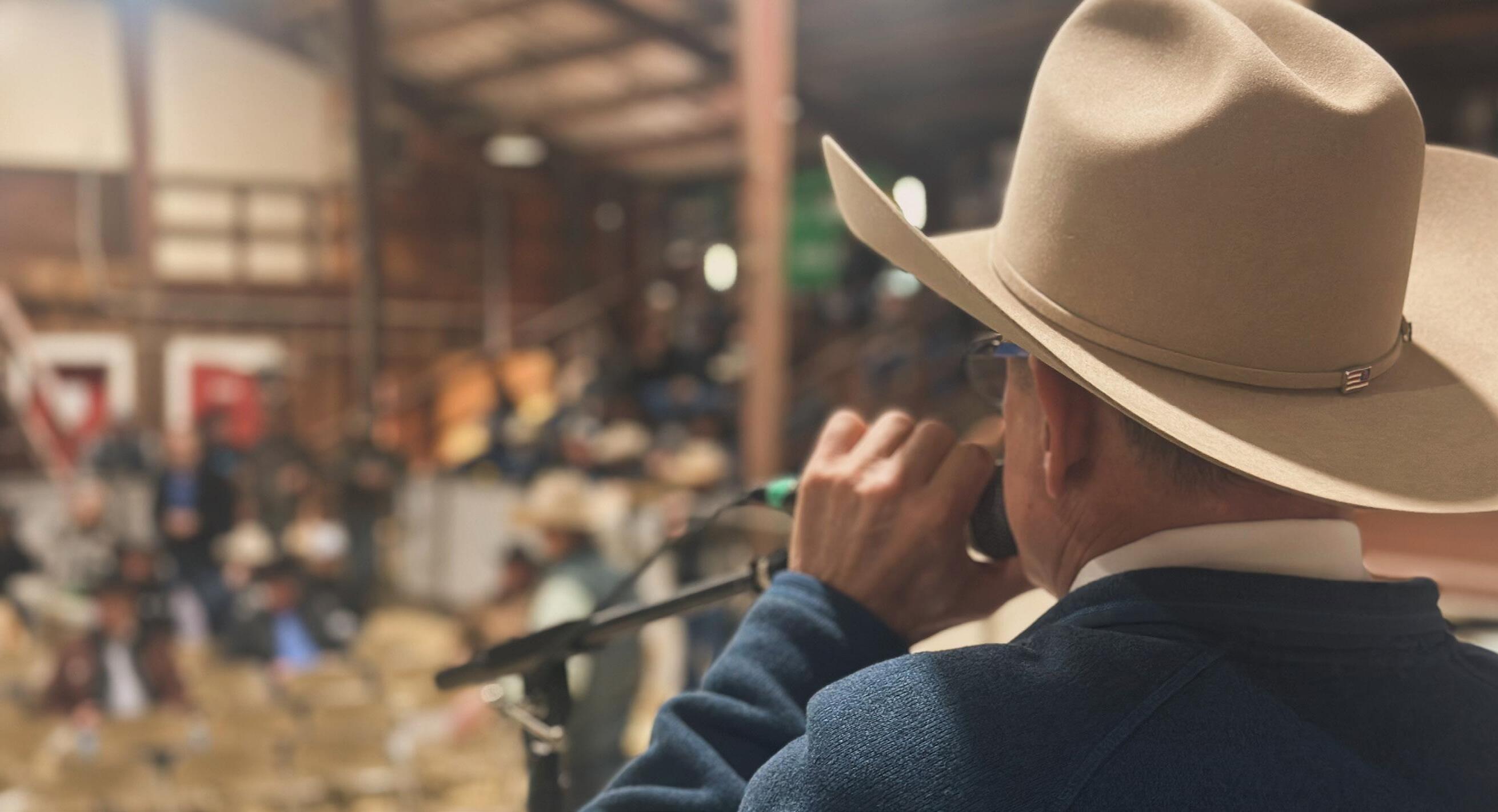



Nevada Beef Council
Cottonwood Ranch in Wells, Nevada, was recognized in February by the National Cattlemen’s Beef Association (NCBA) as a regional winner of the 2024 Environmental Stewardship Award Program (ESAP). Seven regional awards were presented to recipients during CattleCon 2025 in San Antonio.
“Conservation practices of cattle farmers and ranchers across the country help to preserve natural resources and provide wildlife habitat,” said NCBA President Mark Eisele. “The stewardship efforts of these award recipients confirm our industry’s commitment to protecting the land and water for future generations.”
Established in 1991, ESAP celebrates outstanding land stewards in the cattle industry.
Regional ESAP winners come from every corner of the country and undertake stewardship efforts unique to their environment, landscape and resources. The 2024 Environmental Stewardship Award Program Regional winners are:
Region I: Angus Glen Farms, LLC, Watkins Glen, New York
approach for management of the private and permitted public lands has resulted in successful ecological and social outcomes.”
Cottonwood Ranch is a six-generation cow-calf and horse operation in Wells, Nevada. The Smith and Molsbee families are at the forefront of sustainable cattle ranching, realizing that wildlife, healthy lands and livestock can coexist and thrive together through managing both private and public lands as a whole. The ranch has an extensive history of working with federal and state partners to implement conservation practices and is a leader in utilizing virtual fencing for cattle. Cottonwood Ranch has implemented intensive grazing management strategies on their private land that have created more diverse meadows.

Region II: Kempfer Cattle Company, Deer Park, Florida
Region III: Little Timber Farms, Blackduck, Minnesota
Region IV: Blue Ranch, Moore County, Texas
Region V: LeValley Ranch, Hotchkiss, Colorado
Region VI: Cottonwood Ranch, Wells, Nevada
Region VII: Downey Ranch, Wamego, Kansas
“Cottonwood Ranch has demonstrated for decades that they are exceptional stewards of the land,” said Marissa Reed, acting field supervisor of the U.S. Department of the Interior Reno Fish and Wildlife Office. “The ranch’s commitment to a collaborative
Diversification has also played a role in the ranch’s success, with the families expanding their business to include an events venue, hunting operation, veterans retreat and birding and wildlife learning center.
“I feel proud of what we have been able to accomplish,” said Agee Smith with Cottonwood Ranch. “We have been blessed to be caretakers of this land. It’s deeper than just a business, the land just gets in your soul.”
ESAP is generously sponsored by companies and federal agencies who share the cattle industry’s commitment to caring for the environment and protecting natural resources. Sponsors including U.S. Department of Agriculture Natural Resources Conservation Service, Corteva Agriscience, and U.S. Fish and Wildlife Service partner with NCBA to promote environmental stewardship throughout the beef supply chain. For more information, visit www. environmentalstewardship.org.

University of Nevada, Reno researcher develops potential game-changing sorghum varieties for dairy feed and gluten-free foods
The new sorghum varieties provide a climate-smart alternative grain for food science, breweries and dairy farmers
Researchers at the University of Nevada, Reno have unveiled 200 sorghum varieties that could be a game-changer in the food, brewery, dairy feed and biofuel industry. Preliminary research underscores their exceptional drought tolerance, with some varieties also exhibiting record levels of protein and digestible starch.
The breeding program for the sorghum varieties was established in 2017 at the University’s Experiment Station, a unit of the College of Agriculture, Biotechnology & Natural Resources, to develop water-efficient crops suited for the semi-arid Western U.S. The varieties the team has developed may now also present farmers in other regions across the globe with an alternative lower-water-use feed for dairy crops.
"Many dairy feeds and specialty grain crops in the U.S. are facing lower or variable yields due to late frosts, floods, heat and drought associated with climate change, highlighting the need for more resilient alternatives that can thrive under changing climatic conditions,” said Melinda Yerka, the project’s lead researcher and associate professor in the College’s Department of Agriculture, Veterinary & Rangeland Sciences. “Our immediate goal is to collaborate with food scientists and dairy farmers to improve grain yield and farm management practices, which will be important for long-term supply chains.”
In late 2023, Yerka founded Yerka Seeds to complete the development and commercialize the sorghum varieties. With guidance from the University’s Small Business Development Center, Yerka is refining growth strategies, obtaining financing, and addressing intellectual property needs.
Recognizing the potential of the Yerka Seeds, a

We are experts in State of Nevada Water Rights. We provide a wide range of water right and resource development services that can be customized to meet your needs.
Our team works directly with you to develop the best solution for your farm, ranch, business or home.
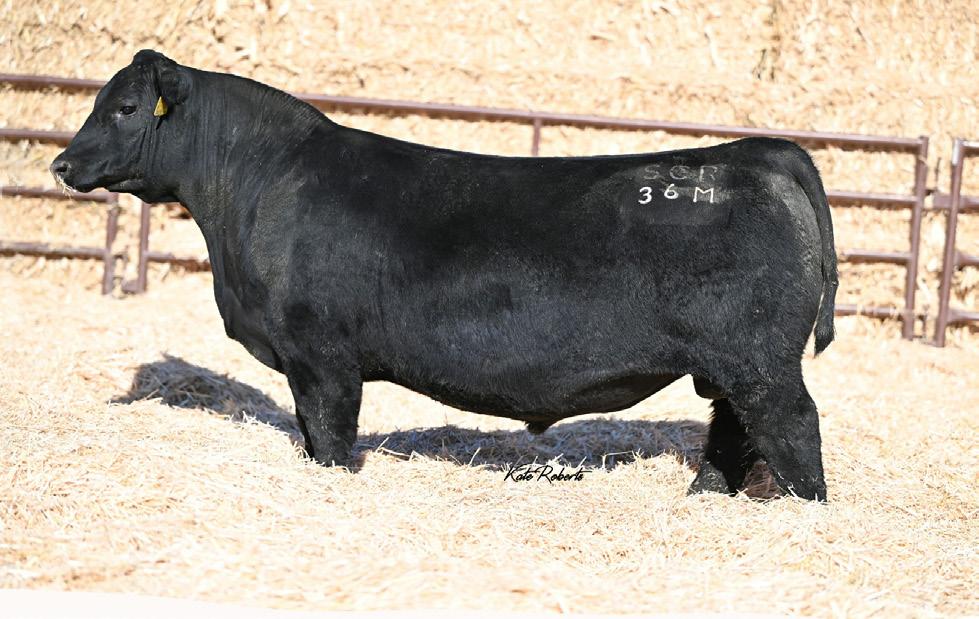

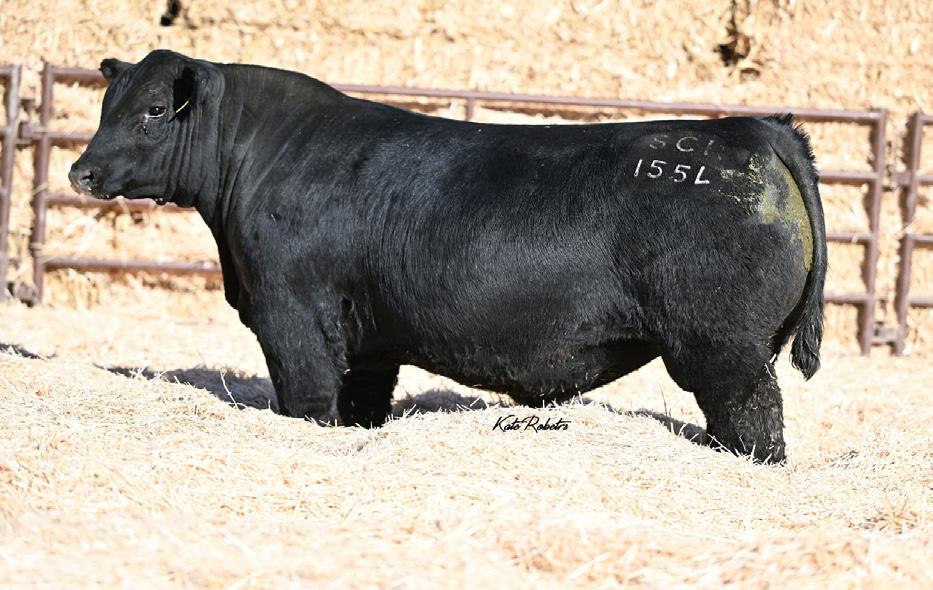
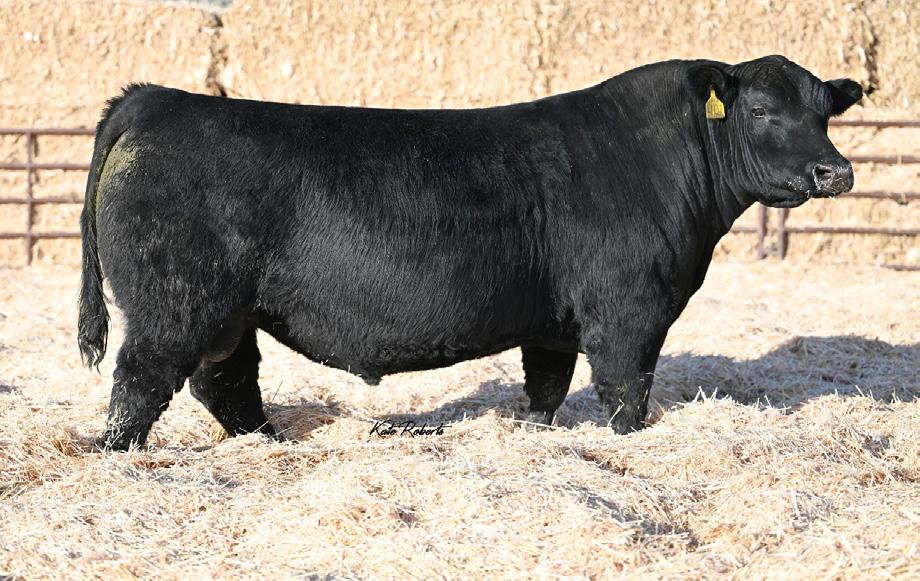

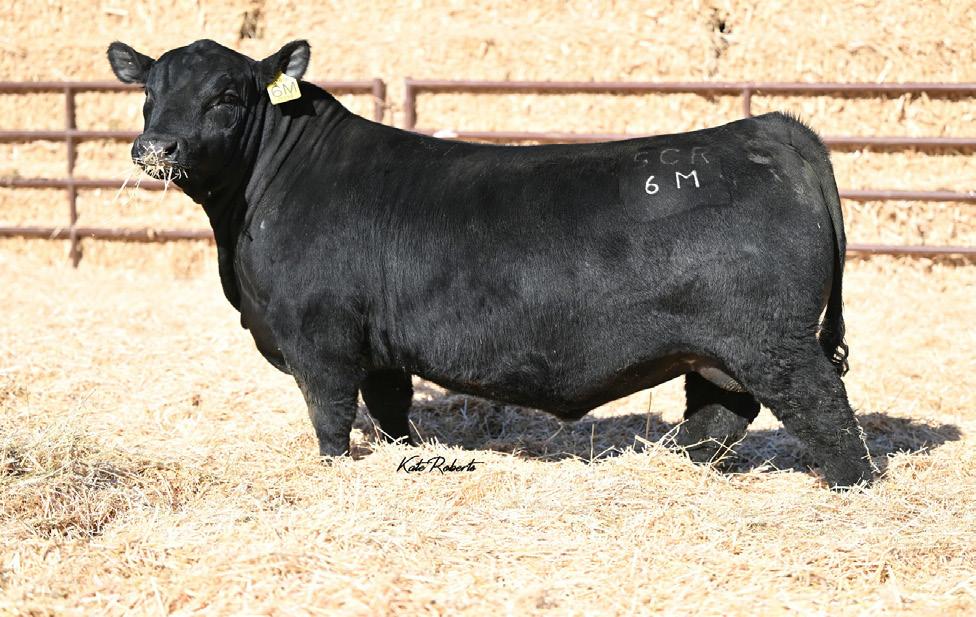

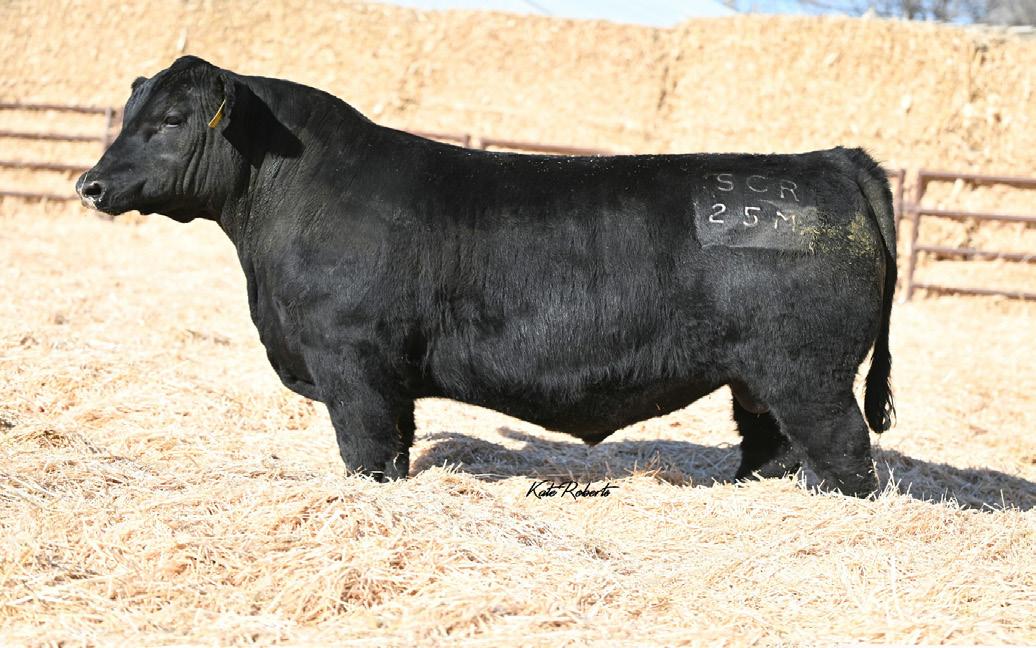
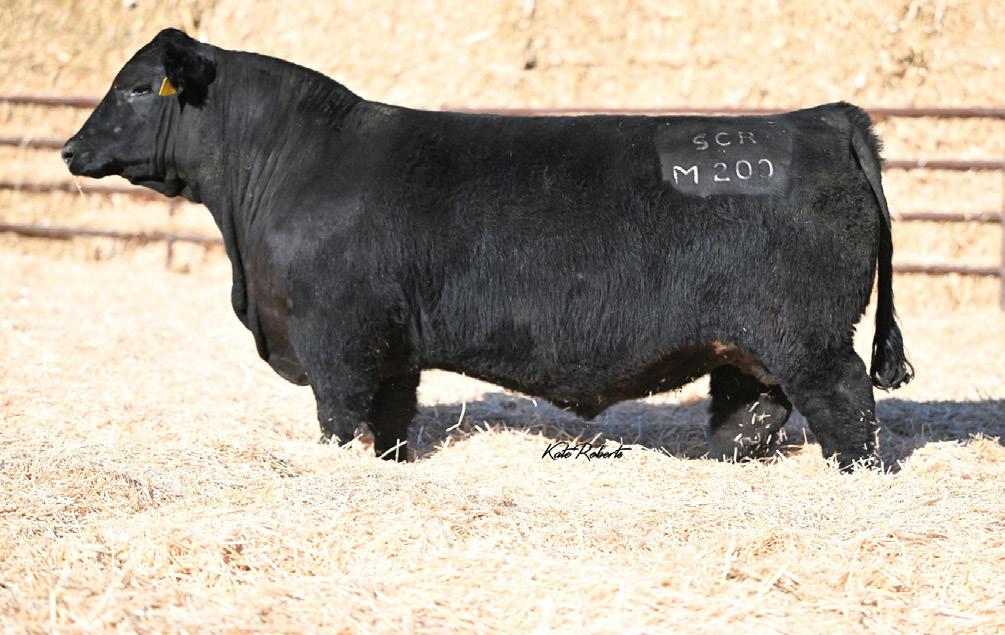
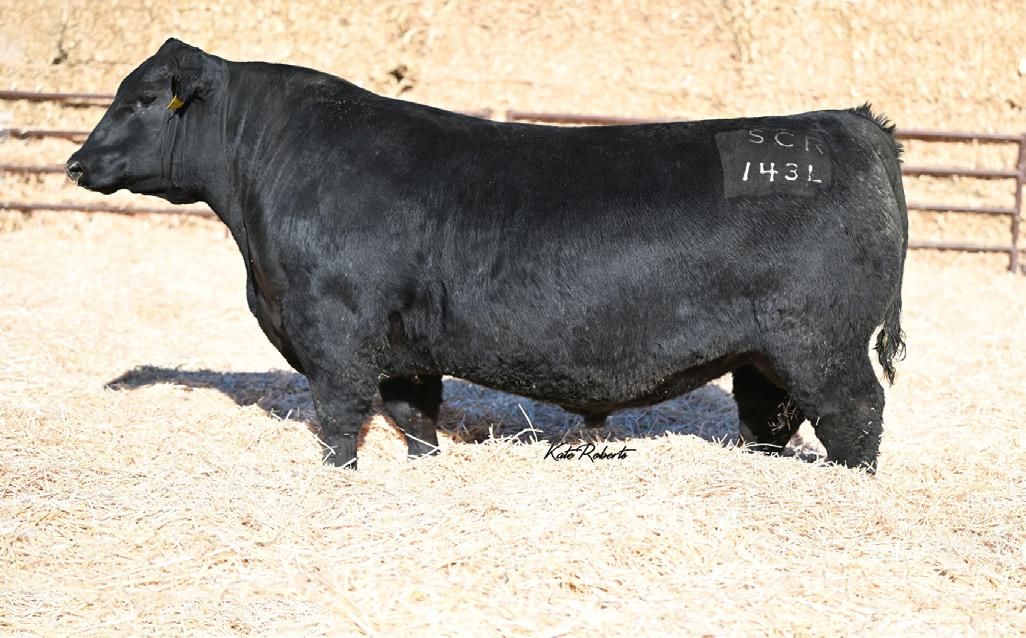
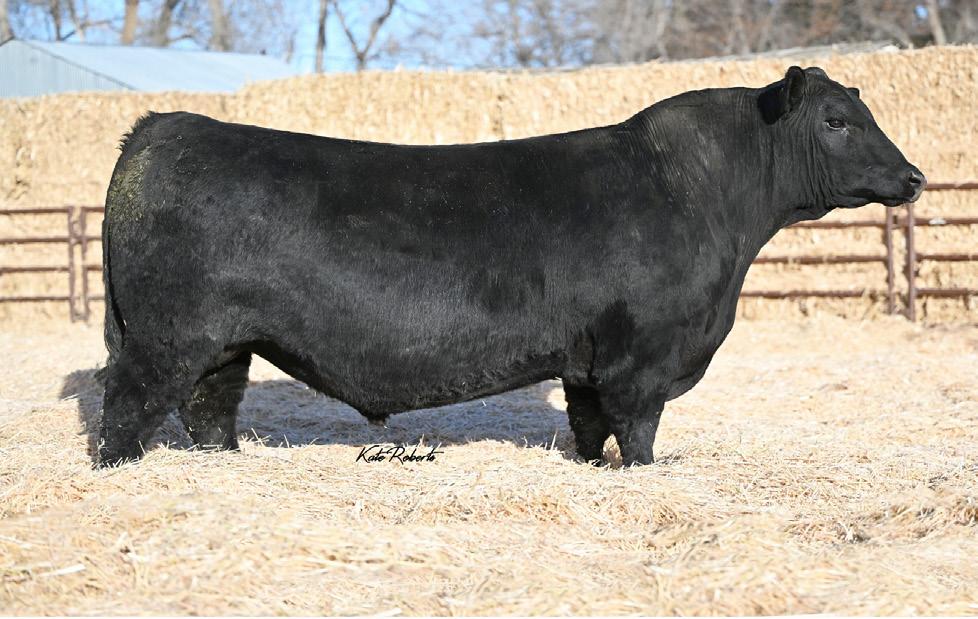

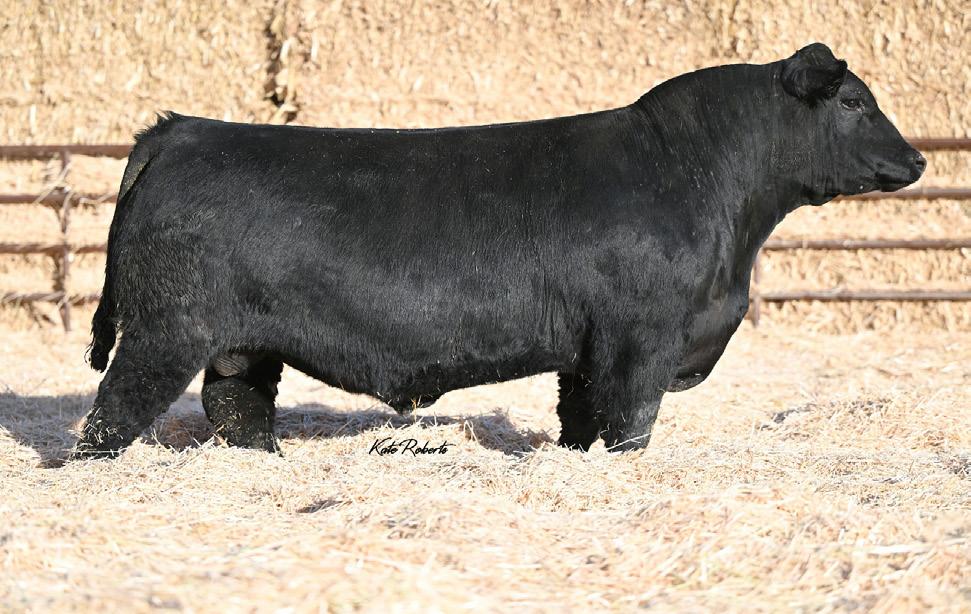

Winnemucca, Nev.—I just love babies! Whether it has two or four legs, there is nothing better than a new baby. I think that is why I love calving season so much (besides the fact that is leads up to branding season!). I really look forward to all the new life. I just don’t think there is anything cuter than a calf tail wagging as it nurses, or baby lambs frolicking on green pasture. Ranching is hard work. It is stressful, we deal with death more often than we like to think about, but those warm springtime afternoon calf and lamb checks sure bring a smile to my face!
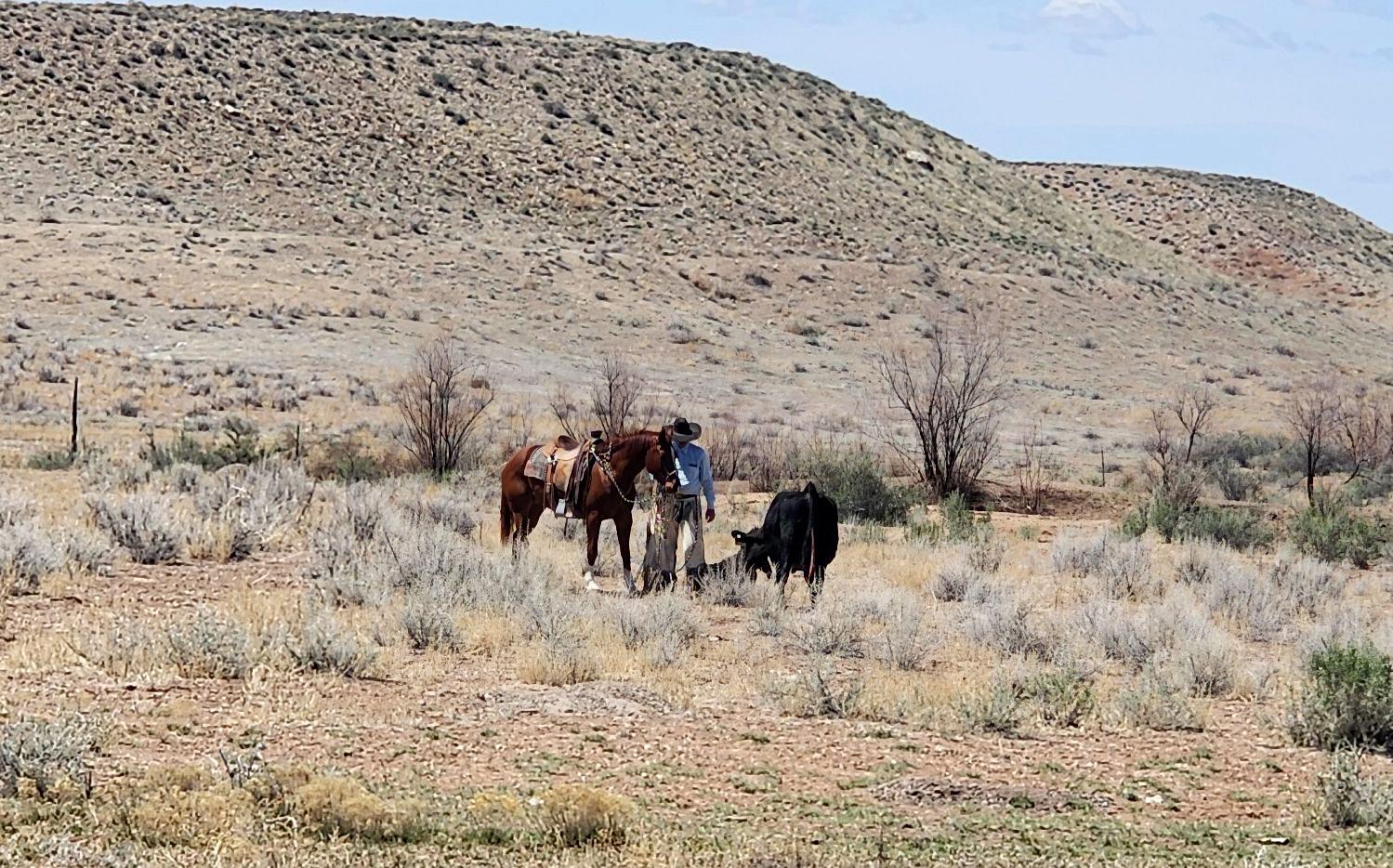





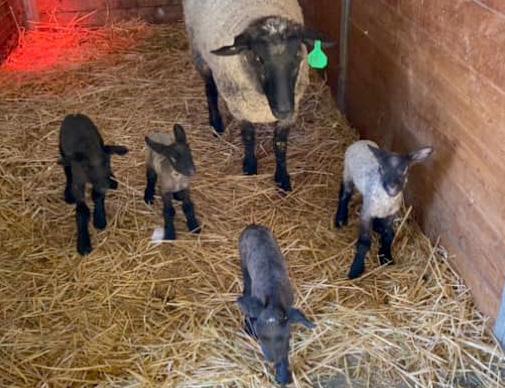
Gene Showalter’s first set of quads in Marsing, Idaho. The ewe raised all four of them. Gene’s mom Gina says “Thankfully she’s had triplets the last 2 years!”


Elko, Nev.—February 1, 2025, Bit, Spur, and Rawhide Romel Rein makers who competed in the Cowboy Arts and Gear Museum’s 6th Annual Bit contestants mingled with the public who came out to admire their talents. Eighteen talented bit makers, 6 spur makers, and 15 rawhide braiders from across the United States and Canada whose experience range from emerging talent to seasoned experts put their individual style and creativity into raw materials to forge truly unique and functional pieces of art. This contest pays tribute to artists, gear-makers, our history, our future, and the passion it takes to keep it all alive.
This year’s theme, Sinners and Saints features the iconic lady leg cheek piece and lady leg spur band from the 1924 catalog, bit # 111 and spur # 150. The makers each brough their own unique twist and inspiration to their design with each submission telling a story.
Father and son duo Richard and Leighton Brooks of Cayley, Alberta, Canada took first place honors in
both the bit and spur contest for the second year now, third year winning the bit contest. Richard first learned gear-building basics in his grandfather’s silver shop (Roy Brooks Sr.) on Roy’s family sawmill/ranch west of Calgary as a young boy. In 2005, after several years of building gear in the evenings and days off from working in town Richard, became a partner in a Canadian buckle manufacturing shop. In 2012, after selling his shares in the company, Richard set up a suitable shop on their ranch (in the Alberta foothills, west of Cayley) and built custom bits and spurs, marking them “R.Brooks” with “Cayley Alberta” in smaller letters below. The father and son team had the second-place bit in 2022. The Brooks duo’s bit sold for $2,050 and spurs sold for $2,200. Larry Lorang of Great Falls, Montana placed second overall in the bit contest. Lorang began building bits and spurs for himself and friends to use around the ranch. In 2023, he was awarded a Traditional Cowboy Arts Association fellowship to further his craft. He says “Building bits and
spurs is my passion and everyday is something new and exciting. His bit sold for $3,900.
Third place honors went to Ryan Looper of Holliday, Texas where in addition to owning a cow/calf operation with his wife Sylvia, operates a bit and spur shop full time. His upbringing and time spent in the saddle has given him an appreciation for quality gear and an appreciation of old-time makers as his work is done through fire and forge on the anvil. His bit sold for $2,750.
The high selling bit, made by Jon Peters of Southern California sold for $9,600. It has 24K gold and pure silver inlay. The steel features deep relief engraving and finished in French gray to make the engraving stand out. It includes a jello mold concho in sterling silver. The mouthpiece is a high port spoon design with copper ferrules and a copper inlay design in the spoon. It is truly beautiful.
Ryan Erickson of western Nebraska placed second in the spur contest. Erickson started building bits and spurs in 1994. He says “His
education in the builder’s trade came from riding with horsemen and working cowboys who were skilled in the finer points of communication between man and horse. His own experiences – from riding pens in feed yards, working for cow/calf and yearling operations to training cutting and ranch horses – have emphasized the fact that a great horseman or woman needs exceptional gear to achieve the highest levels of performance with their equine partner.” His spurs sold for $3,900. He donated his share of the proceeds to Wild Courage, for more information, www. thewildcourage.com
Dean Fisher or Johnson City, Texas clinched third place honors. New to the silver trade, Fisher has been creating bits, spurs, and buckles for only two years alongside managing an exotic game ranch. Dean never stops learning. He enjoys talking to and spending time with other makers, taking every opportunity to learn more and develop his own style. His spurs sold for $1,000.
The high selling spur honors went
CONT PG 16


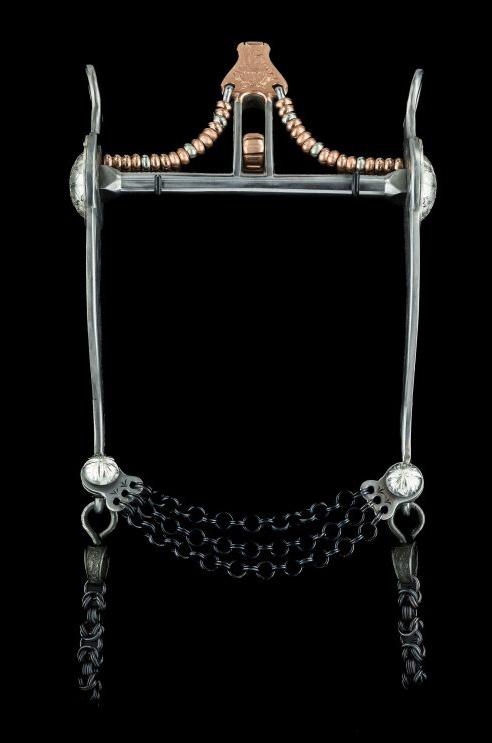
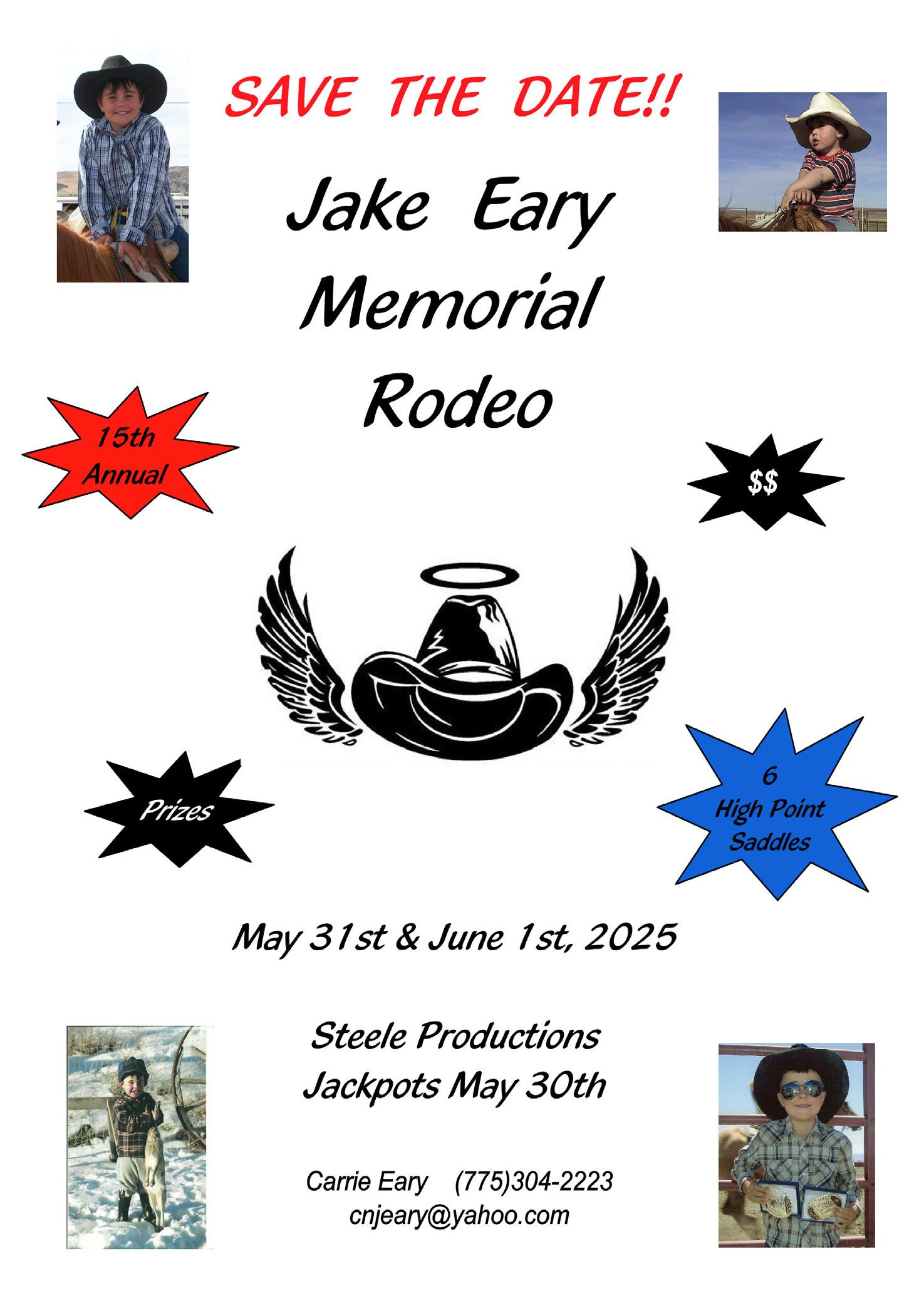
not
style that we would typically build so we struggled with ideas to make unique to what we’d normally build. We chose to stay close to the original designs and build really clean and classy to honor the original patterns. The bit has fine silver inlayed panels and fine silver inlayed wire borders with a touch of engraved steel.”

to Amy Erickson of Evanston, Wyoming, selling for $3,900. Her “Calamity Jane” spurs as she calls them feature a traditional rivet on style shank with my unique C scroll chap guard design. The shanks measure 2 3/4″ and the rowels are 1 3/4″. These beautiful spurs feature multiple copper and sterling silver inlays along with sterling silver overlays.
Nevada braider Dakota May took top honors with his rawhide romal reins again this year. He was always fascinated with the artistry and functionality of handmade gear. Fortunate to have Spider Teller as a mentor in his formative years he learned the old traditions that have been used for generations. Dakota applies the knowledge and techniques he has learned in his travels to each unique piece of gear he builds. He had the top selling reins at $3,900.
Second place honors in the rawhide rein category, as well as the high selling reins for $1,850 went to Mike Skinner of Boise, Idaho. Mike’s interest in handcrafted cowboy gear began early in life and he got his braiding start through the State of Washington’s Folk Arts Apprenticeship program. The goal with each piece of gear is to improve functionality and add refinement,
making each piece a work of art.
Justine Nelson-Graham of Weston, Wyoming rounded out the top three rawhide braiders. Justine began creating tack for her toy horses as a young child and at the age of 15 was introduced to the writings of Bruce Grant and immediately took to braiding anything she could get her hands on. She has continued to hone those skills in this craft, helped along by many of the top braiders in this industry. Her reins sold for $1,300.
New this year, People’s Choice honors went to Jesse Bolton of Northeastern California. Jesse’s approach to braiding focuses on functionality, longevity, and a clean and finished look, as he aims to provide his customers with a highly usable product that lasts long enough to become a family heirloom. His reins sold for $2,000.
Each year the Bit Contest continues to grow! If you are in Elko, swing by the Cowboy Arts and Gear Museum and check out their other exhibits! There are still a couple of bits and spurs for sale. The museum is located at 542 Commercial Street. Follow them on Face Book, or visit their website: http://cowboyartsandgearmuseum.org/

and
and how maybe those two can be hard to tell apart at first glance. That is why the outsides of the bit cheeks look the same. But, if you look closely on the inside, one is hiding a pistol in her garter and the other is holding a cross. Just like real life, don’t judge a book by the cover.”


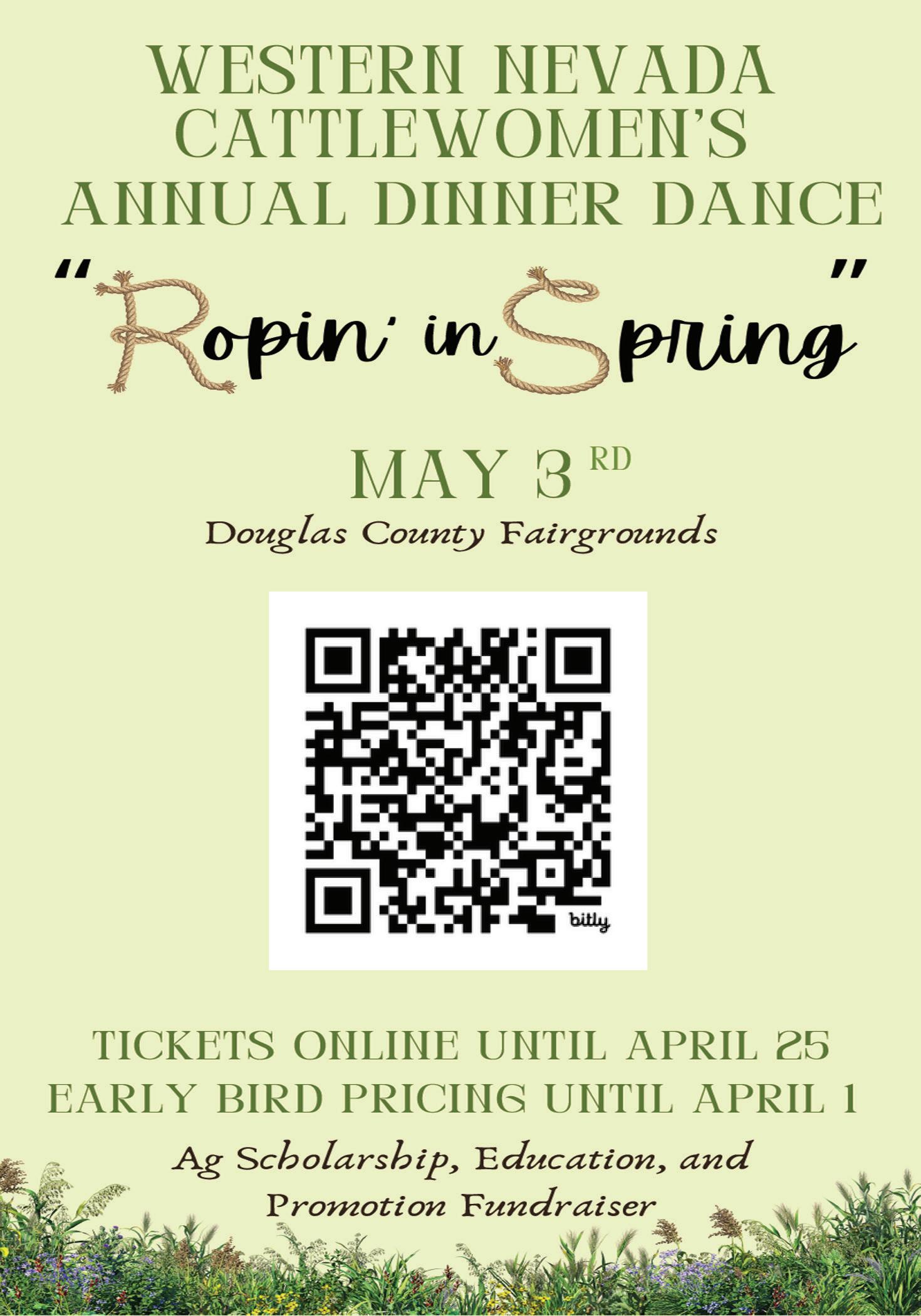
> Top Right 1st place spurs by father and son duo Richard and Leighton Brooks of Cayley, Alberta. “The spurs this year were not a style that we would typically build so we struggled with ideas to make unique to what we’d normally build. We chose to stay close to the original designs and build really clean and classy to honor the original patterns. The spurs have fine silver inlayed panels and fine silver inlayed wire borders with a touch of engraved steel.”
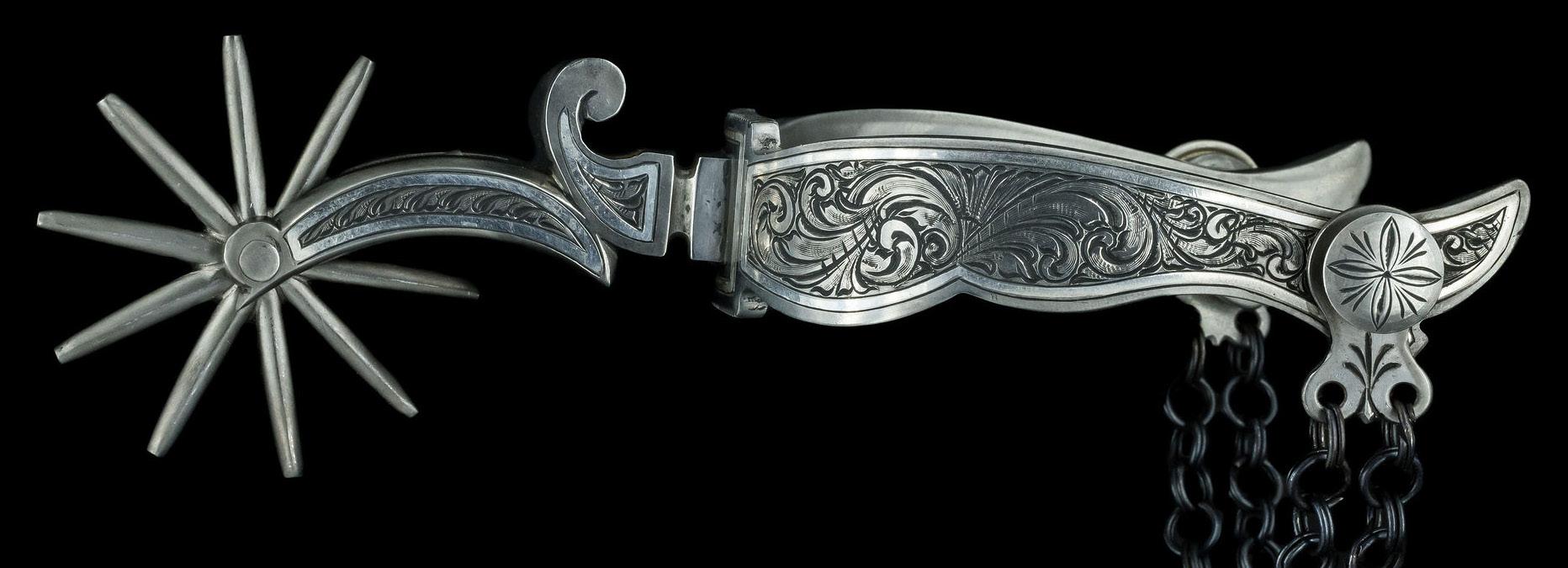
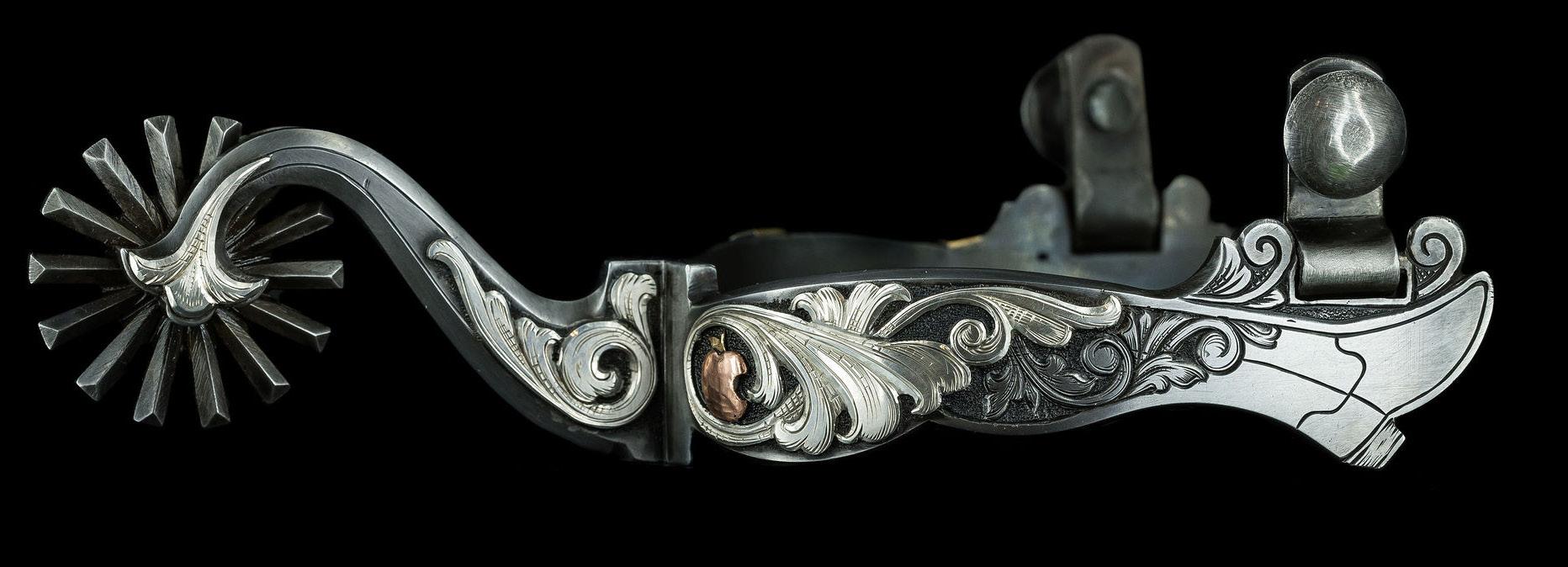
>Middle Right: 2nd place spurs made by Ryan Erickson of western Nebraska. “The struggle of good and evil. These spurs are my interpretation of the moment free will was introduced to the world, Genesis 3, the deception of eve by the serpent. The sterling silver scroll on the outside band is a representation of the Tree of Knowledge, flowing from the bright silver to the dark relief engraving. A representation of the knowledge of good and evil. Centered in the scroll, an apple with one bite taken representing not only the location of the tree in the garden, but also the moment man’s eyes were opened. The smaller scroll at the base of the shank, representing the Tree of Life, is the reason for the expulsion from the garden. The inside band, a serpent wrapping itself around the leg introducing the grip of doubt to Eve. Based on the “gal leg” band pattern, swinging button hangers were added. The goose neck shanks as well as a few other appointments are a nod to some of the makers that I have drawn inspiration from. The
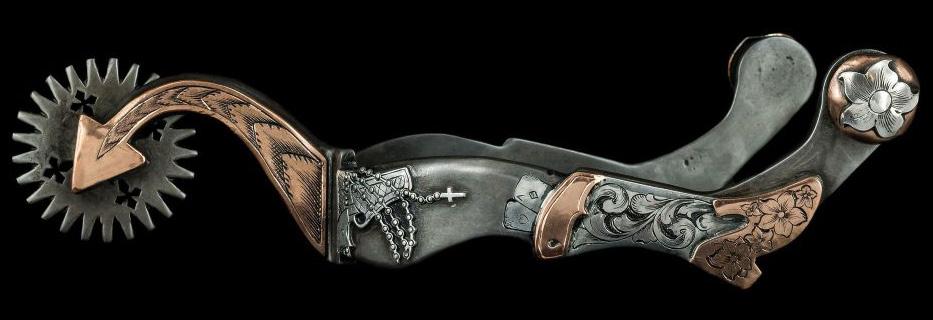
scroll work on the outside of these are sterling silver overlay with a sculpted apple in copper. The inside is a serpent overlay sculpted out of yellow brass. Border inlays are of fine silver with deep relief engraving throughout.”



>Above Bottom: 3rd place spurs made by Dean Fisher of Johnson City, Texas. “I built these spurs trying to keep in mind of the sinners and saints’ theme, the spurs are a mixture of both showing we live in this world but not of this world. The overlays are sterling silver and copper, and the inlays are fine silver.”
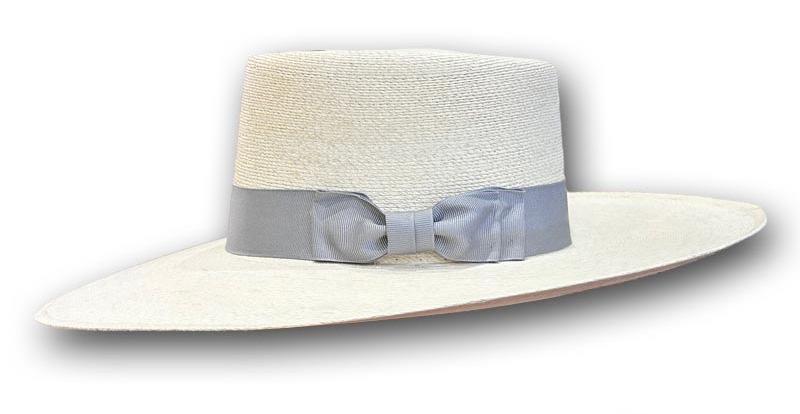

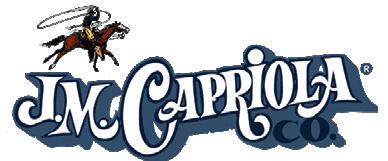


>Above Right: 3rd place bit by Ryan Looper of Holliday, Texas. “I would start with the inspiration for the piece, this came from Gerry Gesell’s short story entitled “Festival Day”, about two sisters. Both having hand made boots, but one takes a more functional/practical approach to her boots. The other being a little more flamboyant and fancy in her boots, matching each personality. The sister that has the flashier boots also has a more flirtatious side to her and keeps a custom made flask tucked in her garter. To give a tip of the hat to Gerry for allowing me to use his story, I included his “Broken 3” brand engraved on her flask. To lend more to the “Saintful” side of the theme, I included the Cross inlaid in 24k gold, along with the Trinity inlaid in fine silver on the spoon of the spade, above both sisters, always watching over them. The rein chain stirrups have a sterling pin cap engraved with a 7 petal flower, representing the seven days of creation. Along with 7 shade lines per petal for the biblical importance of the number 7. The bit includes fine silver and 24k pin stripe inlays on the edges, along with fine silver and 24k inlays on the boots. And finally, sterling silver inlaid bridal rings with the Carlos border engraved in them. Hand sculpted flask, and derringer pistol of sterling silver and high relief engraving throughout the shanks as well as the solid sterling silver conchos. 10” handmade rein chains, swivel rein attach, and forged S hooks. The title of this piece has been dubbed “Popcorn & Confetti “ after the two sisters’ names.”

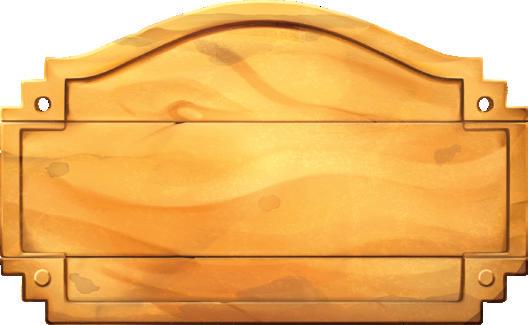


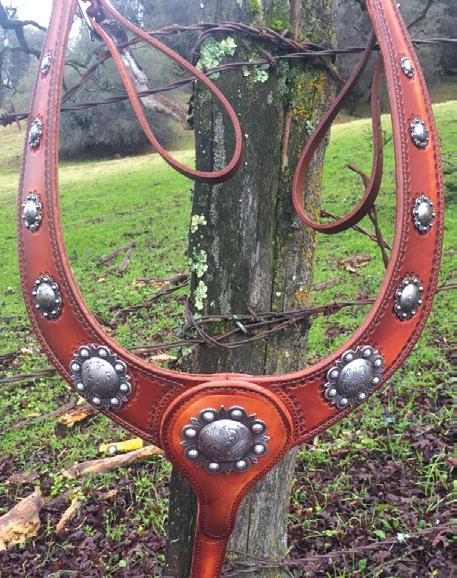

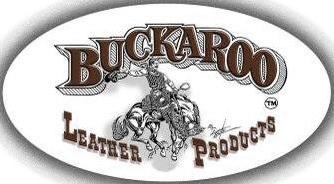



all the small details that make these special.”


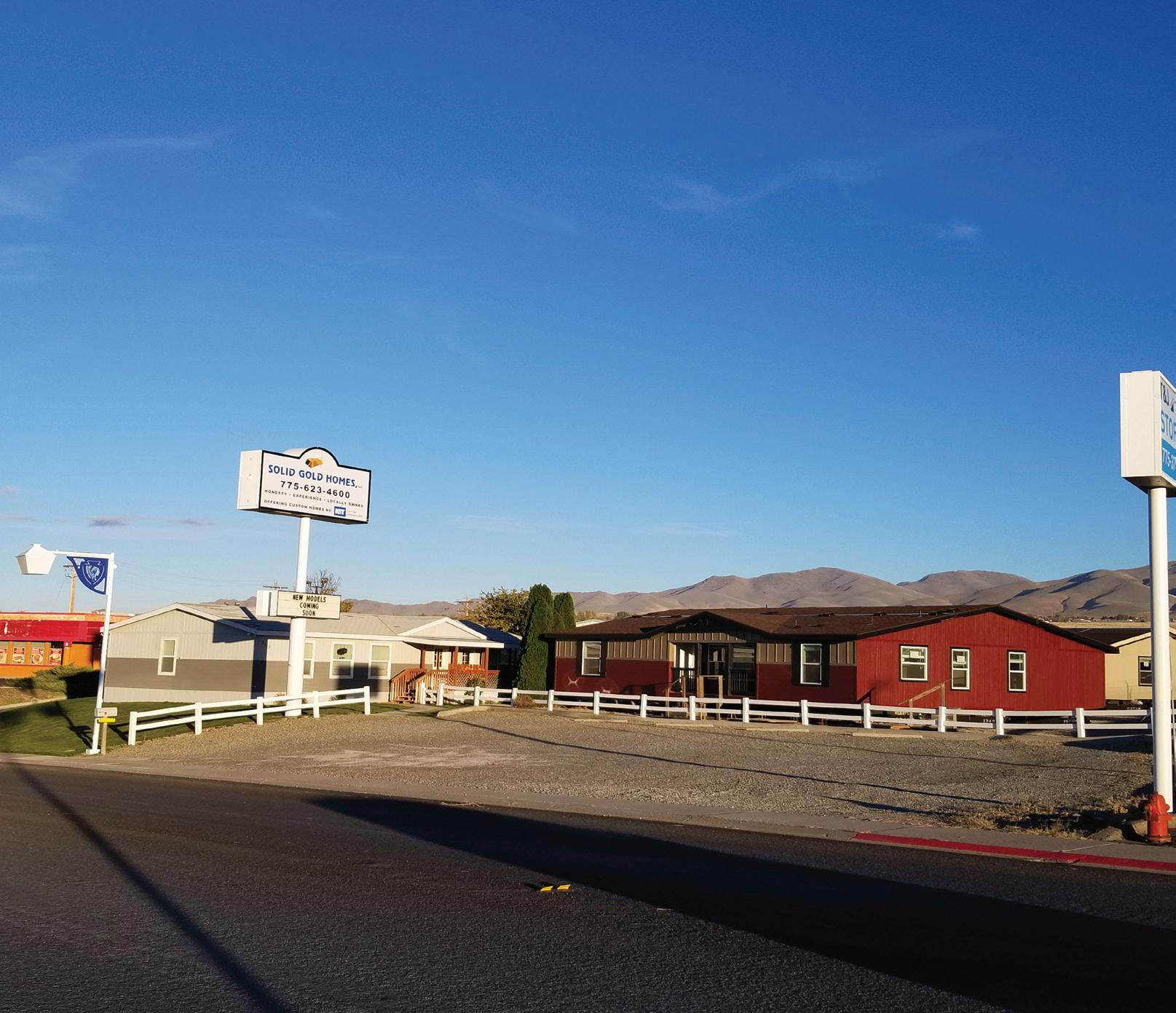
Left and Above: 2nd place Romal Reins made by Mike Skinner of Boise, Idaho.
“Over 500 feet of rawhide strings were cut, sized, split and beveled, then used to braid the bodies and buttons to create this gear. The button string was dyed with cocoa brown to achieve the


two-tone look. The reins and romal include a combination of Western and Argentine braiding styles with the 3 strand Santa Ynes reins with an Oklahoma button pattern and a Trenza Patria rein/romal connector. Rawhide comes from hides that I processed.”

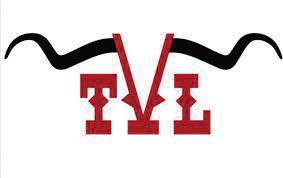




commercial seed production company and several university programs seeking less water-intensive dairy feed have developed pilot studies to assess the varieties’ viability as alternative dairy feeds. The results are promising.
“The field trials confirmed that the seeds perform best on 20 to 25 inches of water per year compared to the 30 to 40 inches that most corn and alfalfa varieties require,” Yerka said.
Yerka is now advancing research to identify the optimal combinations of soil type, climate, fertilizer and water that maximize the seed’s potential. She is also conducting economic analyses of life-cycle costs associated with switching from corn or alfalfa to large-seeded sorghums.
Yerka Seeds: Commercialization pathway
Through Yerka Seeds, Yerka plans to license high-performing sorghum varieties to seed companies capable of producing commercial quantities. She also wants to partner with farmers to supply grain to food science companies or produce silage for dairy cattle.
"We want to be nimble and innovative by emphasizing a closed-loop relationship with food and dairy science organizations, allowing them to specify the grain and biomass profiles they need, which we will then develop while keeping their identity and plant preferences confidential.," Yerka said. "By focusing on the early stages of commercialization, we’re providing specialty grains at a scale that meets market needs too small for larger companies, bridging a historic gap to diversify the flavors, textures and nutritional profiles of sustainable crops."
Last year, Yerka Seeds gained recognition for its innovative work and was selected to participate in the gBETA Reno accelerator program. The free seven-week program, offered by global venture firm gener8tor in partnership with the Nevada Governor’s Office of Economic Development, supports promising startups in pursuing investment opportunities across the U.S.
"What the gBETA program did was help me create a pitch deck and effectively pitch investors and the public," Yerka said.
“They helped me make many professional connections in the national plant biotechnology space, including experts in business development, investment and intellectual property.”
Following her participation in the program, Yerka Seeds was selected as one of the top-10 startups in Nevada in 2024 for Reno Startup Week.
"I wouldn’t have had the confidence to pursue a commercial route for my varieties without the University’s mentorship," Yerka said, crediting the University’s Research and Innovation Program and its Small Business Development Center’s guidance in helping her navigate the complexities of starting and scaling the business.
Global use in gluten-free foods and feeds
The new sorghum varieties have already attracted international attention. Building on the promising grain quality profiles, Yerka has partnered with sorghum breeders at the International Maize and Wheat Improvement Center in Nairobi, Kenya, to develop similar varieties for climates in Kenya, Ethiopia, Tanzania, Uganda,
Malawi, Zambia and Senegal.
“Sorghum originated in Africa, but its unique food qualities remain poorly understood at the genetic level,” Yerka said. “We are working to change that and to develop newer, more high-yielding varieties for foods, feeds and human nutrition.”
Yerka recently consulted on two breeding program reviews organized by the Center in Kenya and its international partners, offering her expertise in sorghum and grain quality. The collaboration focused on evaluating key crop species for Western, Eastern and Southern Africa. Yerka is now traveling between the U.S. and Kenya to conduct inaugural research for integrating her sorghum varieties into the breeding programs.
"Visiting with sorghum breeders taught me that different regions prefer different grain qualities,” she said. “For example, injera, a staple bread in Ethiopia, is best made with waxy starches and soft seeds, while in Senegal, people favor harder seeds for longer shelf life. Fortunately, we have both types of seeds and are already working to identify the genes responsible for these traits to streamline breeding new varieties."
Yerka is currently focused on securing funding to establish regional on-farm variety testing networks across the Western U.S. Her goal is to provide grain samples for the food and brewery industries to develop new products, identify regions that produce
stable flavor and quality traits, and assess the impact of organic and regenerative methods on sorghum quality. She is also seeking funding for her innovative “CrossLock technology,” which prevents cross-pollination by normal varieties to protect specialty grain qualities.
"I’m excited about the progress we’ve made in both the University’s Yerka Lab and Yerka Seeds, but we’re just getting started,” Yerka said. “With the right funding and partnerships, the two teams will be able to make real, meaningful changes in agriculture and the food sciences.”
Support and funding for her team’s research has largely come from the University of Nevada, Reno’s Experiment Station; the U.S. Department of agriculture’s Agriculture and Food Research Initiative, a unit of the National Institute of Food and Agriculture; and a collaboration with Yinping Jiao at Texas Tech University.

Lamoille, Nev.—It’s that time again, time to celebrate everything green! From shamrocks to leprechauns, green beer, Guinness brownies, and corned beef and cabbage, we always have fun on March 17th. A lot of our favorite memories with our boys growing up include Saint Patrick’s Day. Those dang leprechauns were always causing mischief of some sort, and we constructed all sorts of elaborate traps to try and catch one with no luck! Then I’d spend days cleaning up glue, bits of paper and glitter as we finished off a gallon of green milk! It’s too bad high school boys aren’t as much fun as toddlers and elementary aged boys somedays.
Now all these boys of mine seem to care about is food. They want more food. I can’t keep food in our house, I might need to take out a loan just to afford the groceries! These rolls are perfect for St. Patty’s Day. They are a soft, tender, floury white bun that originated in Waterford, Ireland and
are currently made there and South County Kilkenny. They come in two varieties, soft and crusty. The soft blaas (pronounced blah), like these are slightly sweet, light but firm in texture, and melt in your mouth. The crusty blaas are crunchy at first bite, then chewy with a pleasing bitter after taste from the well-cooked, dark crust. They are eaten mainly at breakfast with butter and jam but can be eaten throughout the day with a variety of fillings as they make excellent buns. In 2013, the Waterford blaa was awarded Protected Geographical Indication status by the European Commission.
Blaas are often confused with baps, a traditional Scottish roll that is not sweet. Blaas are square shaped, softer, and doughier, and identified by the white flour shaken over them before baking. There are several different variations of the recipe calling for more or less sugar and different fats. I liked this recipe the best and enjoy them for breakfast with butter and honey. They are so easy to make and you don’t have to wait for Saint Patrick’s Day to enjoy them!


X 1 package or 1 tablespoon yeast X 1 tablespoon sugar X 1/2 teaspoon salt X 1/2 cup butter - softened X 1 1/2 cups warm water X 4 cups flour for rolls, plus additional 3/4 cup to roll them in before baking


1. Add the yeast and sugar to the warm water in your mixer bowl. Let the yeast proof for 5 minutes.
2. Add the flour, salt and butter. Blend with the dough hook until combined. Then knead for 5 minutes or until dough starts to get a shine to it. It will be a sticky dough. Cover and let rise until doubled.
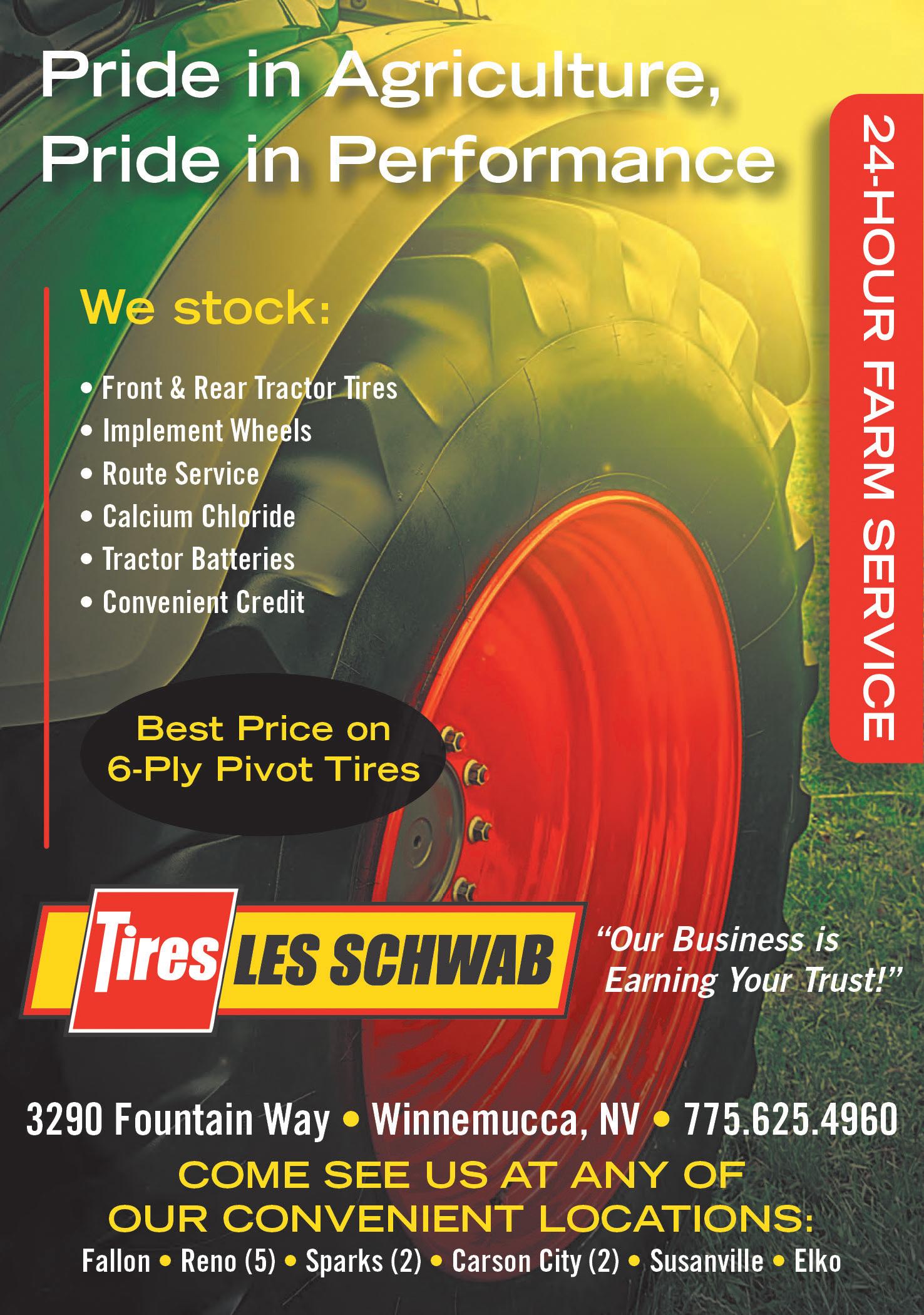
Cross L Ranch, Railroad Valley, Nevada
*3,314 deeded acres *Water Rights *Winter and Summer Range *339,266 acres of BLM to run cattle on *1500-1800 tons per year (to feed and sell) *Cattle and Equipment Included *several home for the help and new home for ranch manager $12,000,000
Segura & Fish Creek Ranch, Tonopah, Nevada
*1,075 acres *support 450-500 head of cattle & 2,500+ sheep *500,000 contiguous BLM land, AUMs for both cattle and sheep with over 1,186,411 acres with 250,725 operating acres *Two 120 acre pivots and a 60 acre pivot *diesel powered wells *50 acres gravity fed irrigation from a pond *1,000 tons of feed annually *sheep pens *home $8,000,000
4. Grease a cookie sheet. Roll the dough balls in the flour again. Place them on the cookie sheet. Cover and let rise again until doubled.
5. Preheat oven to 400 degrees. Bake for 18 - 22 minutes, they will be lightly browned and sound hollow when tapped.
If you prefer, you can do steps 1 and 2 in your bread machine and let the dough rise there.
3. Roll the dough out into a log. Divide into 12 pieces. Form the dough into balls and roll each ball in the 3/4 cup flour. Let rest.

Old Lynn Farm, Railroad Valley, Nevada
*113 acres water rights *Permit 27491 for 111.08 ac. ft. *Permit 38565 for 368.92 ac. ft. *Newer pivots *Small house *Great Starter Farm $479,000 Make offer!
Wildhorse Ranch, North Elko County, Nevada
*Owyhee River Watershed *4,500 contiguous acres with 3116 acre feet of water rights plus 908 supplemental water rights *native grasses *runs 600+ cow calf pairs *summer ground for 1,5001,700 head of yearlings *private land $8,000,000
2623 N Canyon Road, Lamoille, Nevada
*3.68 acres *Corner Lot *Fenced and cross fenced *perfectforlivestock/horses*naturalgrasses *smaller corrals *old single wide *large shed *bunkhouse *Amazing views of the Majestic Ruby Mountains. $350,000
703 Clover Valley Road, Clover Valley (Wells), Nevada
*Bailey

Think for a minute on those you admire. It might be because they are always cheerful, or determined. They may have achieved great success or are calm and steady in all situations. We may look up to someone because they are a good father or mother. We may like the way someone has treated their spouse over decades of triumphs and trials. Perhaps someone is handy with a rope and rarely misses dragging one to the fire, we admire their consistency. Others are able to articulate with confidence, making their point clear.
There are many characteristics and qualities that we find admirable in others. Often we want to emulate these attributes in our own lives. These type of people, are the ones that when you leave their presence, you feel inspired, motivated, ready to just ….do better. When we do this, we actually demonstrate a more positive outlook and are more attractive to others. I would guess, you are probably thinking of someone right now. Now, I realize that some of you are having a hard time thinking of that person you look up to. We have asked people who they admire. There are those who pause and think, ponder, look up at the sky and can’t come up with an answer. I’m sure on their way home, they remember their high school ag teacher, that taught them to weld and didn’t kill them in the process. I’m sure they thought of their neighbor who always stops to ask them about their day and cares enough to listen. Even the cashier at the grocery store that always says, “Good morning” with a smile, has a small but important role amongst those that are admirable.
The reality is, some of us had numerous people who made an impressionable impact on us. However, some have not been as fortunate. Not everyone is raised with godly grandparents or even parents that cared. Some people grew up with such chaos in their lives that it overwhelmed them. The
little influence was drowned out with turmoil at home. But don’t you love the one that overcame huge obstacles in spite of it? There came a point in their life, where they chose to make a change and perhaps that came from the advice of someone else. It may have been, a change of address, a change in education, a job change, choosing a excellent spouse, and of course, changing the crowd they hang out with.
The replacements, didn’t happen overnight but at each turning point, or next best thing to do. We need influencers to infiltrate the lonely, unproductive corners of our lives. They shine the light in dark places, you know, the cobweb covered, spider infested places. With them we can ask questions and learn. We can practice and inquire about mistakes or “what did you do?” to get results. It’s like asking your mother-in-law why her roll recipe didn’t work for you. She may ask, “did you follow what I wrote down, how long did you let the dough rise, did you leave the wooden spoon in the bowl, and did you adjust the oven temperature for altitude?
learn. Are you struggling, unproductive, or just stuck? Perhaps it’s time to reach out to someone who will help sharpen your axe. Let’s go first to the Bible to understand the Biblical meaning of “sharpening our axe”.
Prov. 27:17 says, “As iron sharpens iron, and

one man sharpens another.”
What happens if our axe is dull?
This is what Eccles. 10:10 says, “If the axe is dull and he does not sharpen its edge, then he must exert more strength. Wisdom has the advantage of giving success.”
spouse can be a great teacher and sharpener of our faith
• The Bible is our true source of inspiration. So much so, that God used men to write it exactly how He had planned. 1 Cor. 2:12-13 The Word of God inspires, so get around those who use it correctly to sharpen you, as you sharpen them.
• Jonathan and David had one of those rare friendships that cut straight to the truth. When Jonathan’s father Saul, seeks to kill his best friend, David, he goes out to him and helps him find strength in God. 1 Sam. 23:15-18. Sharpen one another by pointed each other to God, as the source of strength.
• Jonathan also reminds David of who he will become, the king over Israel. Also found in 1 Sam. 23:15-18. The admirable person reminds us of who we are to become even if it exceeds their own personal position. Sharpen each other to remember our wise and godly position.
• When we admire someone we often use the word love. We will say, “I just love her so much, I just love that man, he’s a good one”. This is how we know this is true love, according to James 2:8 “If, however, you are fulfilling the royal law according to the Scripture, 'YOU SHALL LOVE YOUR NEIGHBOR AS YOURSELF,' you are doing well.”
"How else do we learn if we don’t ask. We always need someone to look up to, no matter what we’ve achieved, our age, how knowledgeable we think we are, or our economic status."
We are never so good that we don’t need someone to learn from. You know the saying, “it’s lonely at the top”, that is only true for those who think they have nothing to
The notes for this verse explain that a little wisdom helps ease the efforts of life. It also says that life often doesn’t turn out like we expect. However, wise living produces a good outcome.
This is how we sharpen our axe and sharpen on another's axe to navigate through life with good sense.
• We need one another, let’s face it. We are designed to fellowship with each other. Even Adam was not meant to be alone, Gen. 2:18, he was given a wife. Our
March marks National Nutrition
Month, a time dedicated to highlighting the importance of making informed food choices and developing healthy eating patterns. For Nevada’s cattle ranchers, this month is a perfect opportunity to see how your Beef Checkoff investments are making a difference in promoting beef as a nutritious part of a balanced diet.
The Nevada Beef Council (NBC) is proud to represent the hard work and dedication of our state’s producers by ensuring that beef’s nutritional value is recognized when presented to Nevada consumers and supported by research. Through strategic initiatives, the NBC works to promote beef’s nutritional benefits to consumers, health professionals, and thought leaders.
Investing in Nutrition Research
One of the primary ways your Beef Checkoff investments are put to work is through ongoing nutrition research. Recent studies funded by the Beef Checkoff, including the Beef WISE study conducted by the University of Colorado Anschutz Health and Wellness Center, show that lean beef can support
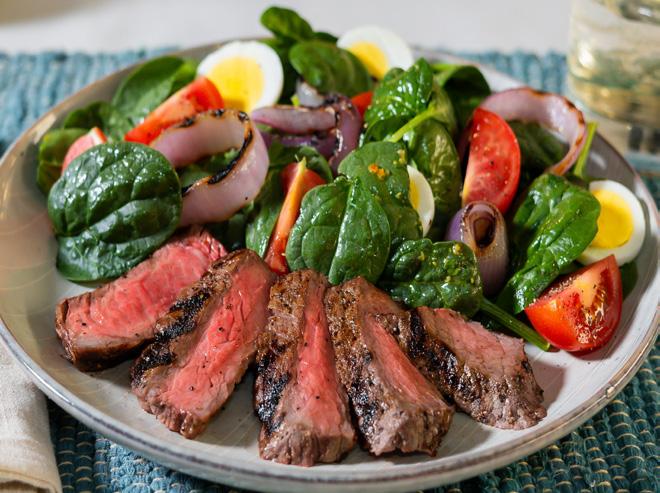
heart health and help maintain muscle mass, both of which are vital components of a healthy lifestyle.1 These findings are shared with dietitians, physicians, and fitness professionals, positioning beef as a trusted source of high-quality protein, iron, zinc, and B vitamins.
“The research supported by the Beef Checkoff emphasizes what ranchers have known for generations: beef is a nutrient powerhouse,” said Nevada Beef Council Executive Director Bill Dale. “By sharing these findings with health professionals and the public, we’re helping to ensure beef remains a trusted choice at the dinner table.”
Reaching Health Professionals
Across the State
Kicking off 2025, the NBC is
expanding its outreach to medical offices across the state to share the latest research on beef’s nutritional benefits. By providing physicians and healthcare professionals with credible, research-backed information through beef toolkits, the NBC helps ensure beef remains a trusted source of protein for patients looking to maintain a balanced, nutrient-rich diet.
The NBC’s efforts focus on key areas such as nutrition for infants, toddlers, and teens, as well as the role of lean beef in supporting heart health. By addressing these specific life stages and health priorities, the NBC highlights beef’s versatility and importance in promoting overall well-being.
Celebrating Producers’ Impact
As a Nevada cattle rancher, you play an essential role in producing the high-quality beef that fuels these efforts. Your dedication to raising cattle is the foundation of every checkoff-funded initiative.
Together, we are ensuring that beef’s nutritional benefits are recognized and celebrated, not just in March, but year-round.
I recently read an article about how we sharpen one another as Christians. We consistently spend time together, exhorting, encouraging, admonishing, reading and praying for each other and over God’s Word. The more we do this, the sharper we become. You could say, we are cutting edge in ministry to each other and our community. We are ready to meet the needs of those around us and have a love for furthering the Kingdom of God.
I always apprreciate you reading! Now let’s get out there and sharpen those axes!
They are the fellas we look up to, Who sit on the fence and laugh at you, Joke with each other about the mistakes you make,
But you let it slide ‘cause they used to made the same, They tell stories at dinner about old hands and hard mounts, We sit on the edge of our seat, forks halfway to our mouths,
good advice, “Go talk to her, Boy!” or “Hold your dallies right.” Some we have never met, just heard about in stories, Great Grandfathers, war heroes, and bronc riding glories,
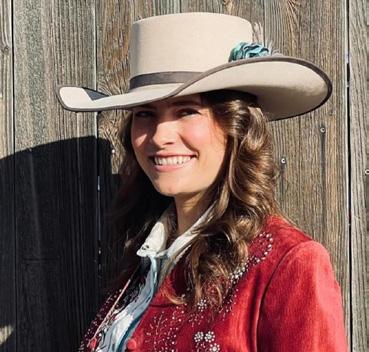
Some are loud and a little over the top,
Others are quiet but their voices make conversation stop, Some land somewhere in between
But everyone around them is always laughing, Always handy with some
The kind of hands that we strive to be, Their sense of humor or just to be that handy, They pass down their traditions and some kids roll their eyes, They’re tough because of long miles, snug bedrolls, and drafty bunkhouse nights, They will coach your riding and pick on your hat shapes, But it’s the scars that make the man not his rope lengths, You can learn a little from anyone and once you’ve won your spurs, Someday you just may join the ranks of those Timeless Characters.
By Randi Johnson
2013
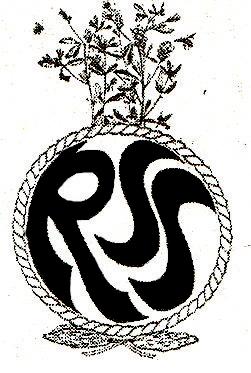
6 439 H VX R 6497R 6516R 6517R
WL 336HQ.RR
WL 356HQ.RR
WL 372HQ.RR
Oats
Wheat
Peas
Corn
Sorghum Sudan
Triticale
Ryegrain
Beardless Barley
Cayuse
Monida
Twin
PR 1404
Patrone
Dundale
Sweet/Field
BMR
Piper Sudan
Sweet RN
Honey
Forerunner
Surge
Gazelle (Spring)
Prima (Fall)
VNS
Eureka
Chowford
Stockford
Cinch (ML)
Cinch II
Ron’s Blend
Spredor 5
Ladak
Wheatgrasses
Nordan Crested
New Hy/Saltlander Bluebunch
Hycrest Crested
Siberian Wheatgrass
Oahe Intermediate
Pubescant
Indian Ricegrass
Big Sagebrush
Forage Kochia
Alsike
Ladino
Red Clover
Strawberry
White Dutch
Yellow Blossom
Trefoil
organically approved and non-GMO seed varieties available.
Vernal
Ranger
WL 343HQ
WL 354HQ
WL 363HQ
& RECLAMATION SEED
Immigrant Kochia
Snowstorm (New)
Great Basin Wild Rye Roadcast
Tall Wheatgrass
Shadescale
4 Wing Saltbrush
Garrison Creeping
Meadow Foxtail
Range Changer
Orchard
Teff Grass
Mountain Meadow Brone Smooth Brome
Annual Rye Grass
Perennial Rye Grass
Climax Timothy
Ron’s Elite
University w/ No Clover
Roa’s Pasture
Horse Pasture
Ron’s Dryland Mix
Ron’s Rangeland Mix
Ron’s Special Turf Mix
KY Blue Grass
Athletic Turf Mix
TT Perennial Ryegrass
Chewings Fesque
Bentgrass
Manhattan Lawn

Jake Parnell 916-662-1298
George Gookin 209-482-1648
Rex Whittle 209-996-6994
Mark Fischer 209-768-6522
Kris Gudel 916-208-7258
Steve Bianchi 707-484-3903
Jason Dailey 916-439-7761
Tod Radelfinger .................. 775-901-3332
Bowdy Griffen 530-906-5713
Brett Friend ........................... 510-685-4870
WEDNESDAY WEEKLY SCHEDULE
Butcher Cows ................................... 8:30 a.m.
Cow-Calf Pairs/Bred Cows 11:30 a.m.
Feeder Cattle ........................................ 12 p.m.
AUCTION MARKET
12495 E. STOCKTON BLVD., GALT, CA
Office........................................... 209-745-1515
Fax 209-745-1582
Website/Market Report ... www.clmgalt.com
Web Broadcast www.lmaauctions.com California’s livestock marketing leader
Top Consignments from throughout Nevada and Beyond will be Showcased during These Upcoming Special Sales ...
SALES
WEDNESDAY, MARCH 5
WEDNESDAY, MARCH 19
WEDNESDAY, APRIL 9
WEDNESDAY, APRIL 23
WEDNESDAY, MAY 7
REGULAR FEEDER SALES EVERY WEEK Join Us Ringside Every Wednesday at 12 p.m.
CLM ANNUAL BRED COW AND PAIR SALE
New Date for 2025: Saturday, August 9

CALL TO CONSIGN TO THESE WESTERN VIDEO MARKET SALES: March 21 – Cottonwood, CA
CONSIGNMENT DEADLINE: MARCH 13
April 10 – Cottonwood, CA or Coalinga, CA CONSIGNMENT DEADLINE: MARCH 24
May 1 – Cottonwood, CA or Coalinga, CA
CONSIGNMENT DEADLINE: APRIL 15
Sale Consignments: www.wvmcattle.com



